GOLF EXPERIENCES FOR HER WITH GIA LIWSKI
the golf kitchen culinary excellence awards at glenarbor golf club

RAISING THE BAR
A COMPREHENSIVE DYNAMIC & NEW APPROACH TO WINE REVIEWS FOR PRIVATE CLUBS
callie Meyer pastry chef
wycliffe golf & country club
COVER STORY rising star

HANNAH FLORA-MIHAJLOVIC MIZNER COUNTRY CLUB
celebrating 100 years clos des Mouches
Being grateful greens do good and the reed foundation honor executive chef anthony villanueva
www.GolfKitchen.com September 2021 - February 2022

The Tusk Lion Trail 2021
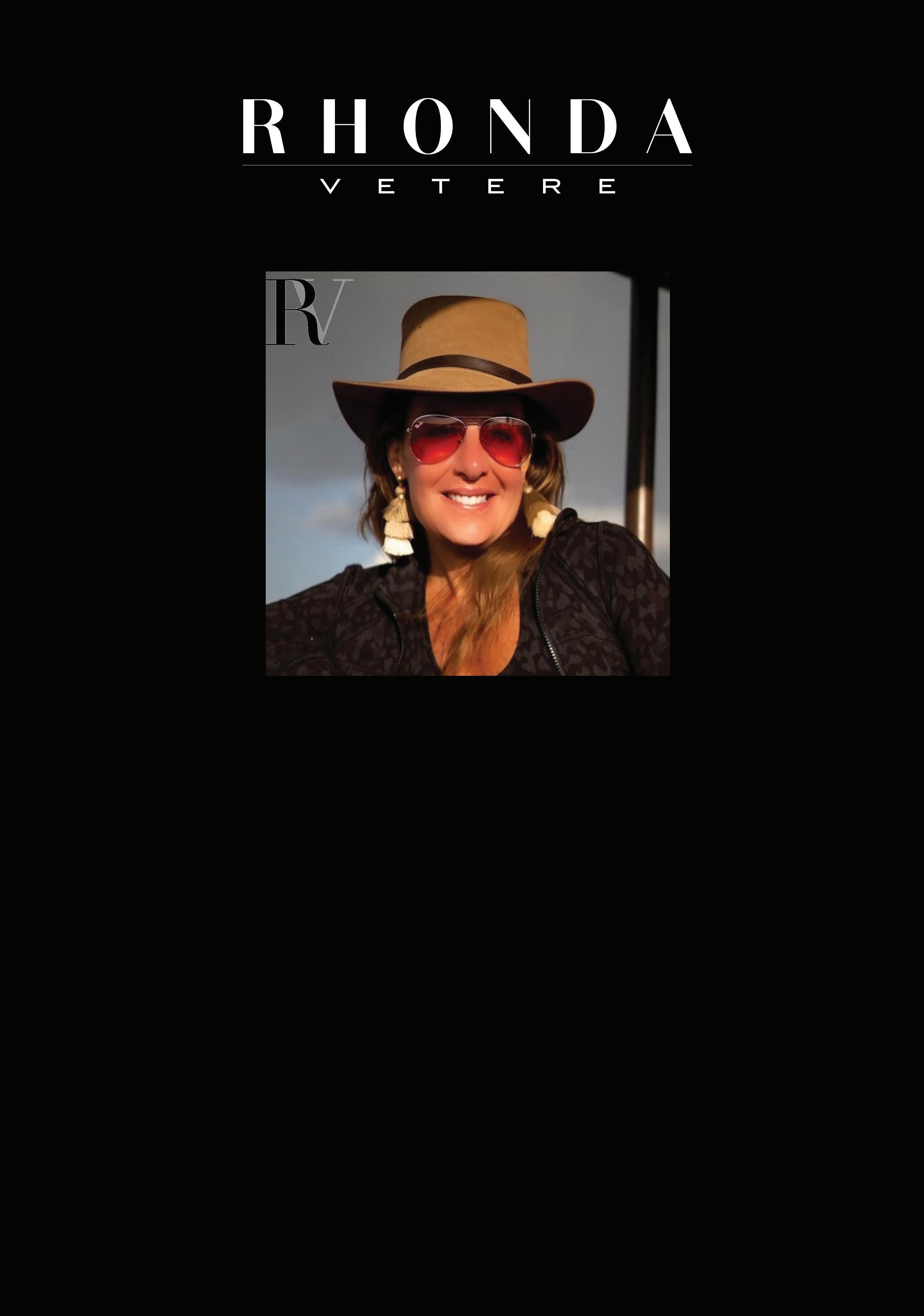
A global celebration of African lions and the people who live alongside them through exceptional art.
47 life-sized lion sculptures, designed and made by some of the planet’s foremost artists, musicians and sportspeople, are roaming streets around the world to highlight the threats currently faced by ‘the King of Beasts’, and to raise vital funds to support community conservation and livelihoods impacted by Covid-19 across Africa.
Curated by Chris Westbrook, this is an art trail like no other. The sculptures take you on a tour of iconic locations around the globe, from Piccadilly Circus in the heart of London’s West End to the forecourt of New Zealand’s Parliament building in Wellington. The lions bring to life the stories of these iconic predators as well as the people who work tirelessly to protect them.
Look out, world. The lions have landed!
www.RhondaVetere.com
Golf Kitchen Magazine is a biannual publication of Golf Kitchen LLC. Copyright 2021. Print subscriptions are available at www.golfkitchen.com for $59.99 per year.
All rights reserved in all countries. Contents may not be reproduced in any manner without written permission of Golf Kitchen LLC. Golf Kitchen LLC does not necessarily agree with the viewpoints expressed by our contributing writers of articles and advertising copy.
For advertising opportunities please email us at info@golfkitchen.com
Golf Kitchen welcomes letters to the editor at info@golfkitchen.com
The Golf Kitchen Wine Program award is selected and presented at the Golf Kitchen Culinary Excellence Awards annually and determined by an independent team of wine judges based in New York, led by Fernando Silva, Sommelier, Wine Critic, and Wine Educator.
GK Wine Reviews are a unique sales tool for winemakers globally and assist in private clubs becoming aware of your brand. Wine reviews are an outstanding sales and educational tool to improve the wine program at your club.
For more details please email: FSilva@GolfKitchen.com
GOLF KITCHEN Magazine
Let us take care of you the way we take care of our reputation.



RAISING THE BAR A COMPREHENSIVE DYNAMIC AND NEW APPROACH TO WINE REVIEWS FOR THE PRIVATE CLUB INDUSTRY

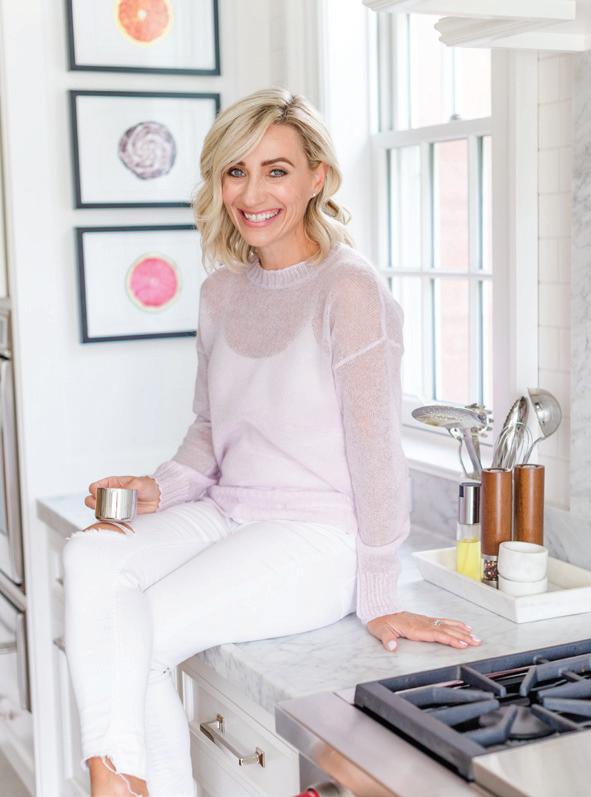

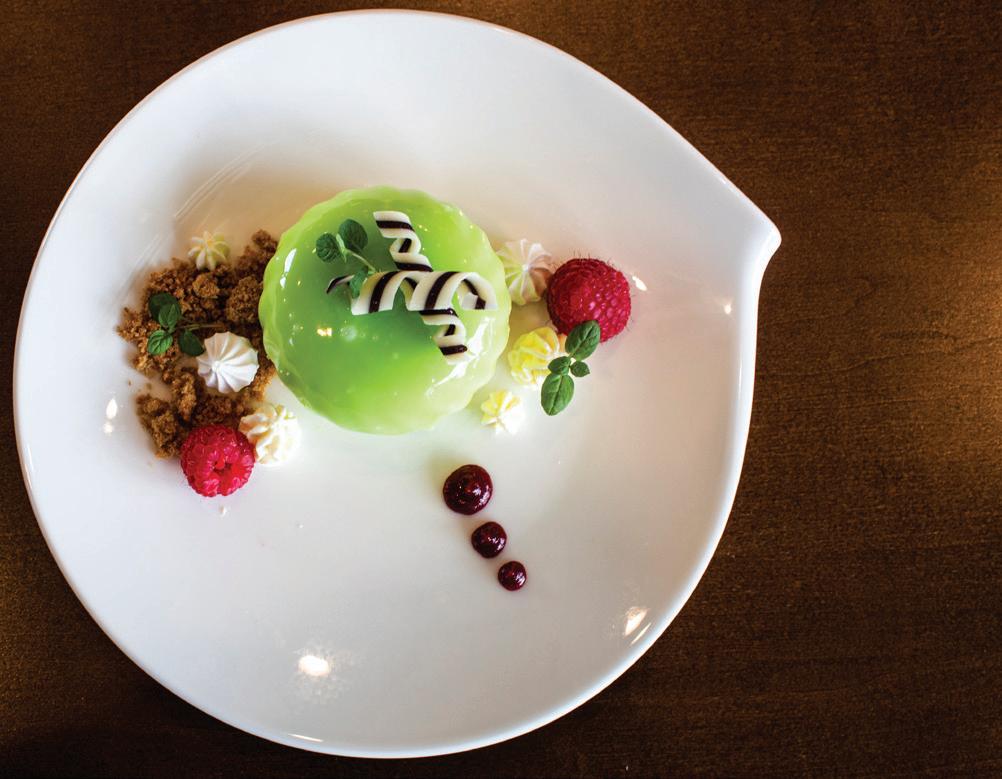
41 CONTENTS MARCH 2021 | AUGUST 2021 58
PASTRY
WYCLIFFE GOLF &
CLUB 14
STORY: HANNAH FLORA-MIHAJLOVIC EXECUTIVE CHEF AT MIZNER COUNTRY CLUB 46
GIA LIWSKI
CALLIE MEYER EXECUTIVE
CHEF AT
COUNTRY
COVER
GOLF EXPERIENCES FOR HER WITH
52
58 46 52
Data Management Redefined

More than 80 percent of enterprise data is scattered across multiple locations on-premises and in public clouds, trapped in infrastructure silos, and buried unseen in long forgotten storage systems, making it almost impossible for IT to control – still less exploit for business advantage.


Cohesity eliminates this mass data fragmentation problem with a web-scale, data management platform that radically simplifies the way companies protect, control and extract value from their data. This software-defined platform spans across clouds and data centers, can be managed from a single GUI, and enables independent apps to run in the same environmentjust like the smartphone.

Learn more about Cohesity at cohesity.com © 2020 Cohesity, Inc. All rights reserved. Cohesity, the Cohesity logo, SnapTree, SpanFS, DataPlatform, DataProtect, Helios, and other Cohesity marks are trademarks or registered trademarks of Cohesity, Inc. in the US and/or internationally. Other company and product names may be trademarks of the respective companies with which they are associated. This material (a) is intended to provide you information about Cohesity and our business and products; (b) was believed to be true and accurate at the time it was written, but is subject to change without notice; and (c) is provided on an “AS IS” basis. Cohesity disclaims all express or implied conditions, representations, warranties of any kind. Run Apps One UI One Platform
“Cohesity is committed to continuous innovation, consolidating and simplifying the management of data centers and clouds. That’s how we are going to help change the world.”
MOHIT ARON, CEO










YOUR PASSION IS OUR SCENE! Issue_38 42 CONTEMPORARY CULTURE 43 VenuMagazine.com CONTEMPORARY CULTURE Issue_28 For a complimentary digital Venü subscription, sign up for the Ü-List on our website:



CONTENTS 83 REED FOUNDATION FOR AUTISM HONORS ANTHONY VILLANUEVA EXECUTIVE CHEF AT EDGEWOOD COUNTRY CLUB 57 72 CELEBRATION 100 YEAR CLOS DES MOUCHES 72 83 GOLF KITCHEN CULINARY EXCELLENCE AWARDS 2021 AWARDEES 14 COVER STORY: HANNAH FLORA-MIHAJLOVIC EXECUTIVE CHEF AT MIZNER COUNTRY CLUB
FROM THE EDITOR
Hello all,
What a wild, unfathomable few years we have all endured; thank God for golf, food, and wine. A community that I fell in love with over ten years ago.
The pandemic has been a boom time for the golf industry, but what comes with that is the challenge to find talented staff. There is little awareness within the younger population that the private golf and country club industry has an excellent culinary career path, both front, and back of the house. My goal is to bring this to the forefront. Enter our cover story Hannah-Flora Mihajlovik, Executive Chef at Mizner Country Club in Delray Beach, Florida.
Mihajlovik, who is 28 years of age, is a fierce, creative force at the club. She has a team that she encourages to share their culinary visions to create new recipes and believes this is why they love to work at Mizner and in her kitchen. The club recently launched a Culinary Lab program, and if participants complete the course, the club will fully pay for an American Culinary Federation (ACF) accreditation.
Before the pandemic, I had traveled to Wycliffe Golf and Country Club in Wellington, Florida, and found another club that has embraced a younger team. Callie is a favorite with the members and creates some visually stunning recipes for us!
More women in the industry! Check out Gia Liwski’s Golf Experiences for Her. Liwski, a golf coach, has created her own business by focusing on positive and feminine experiences for small groups of women at participating golf and country clubs. She effortlessly brings the golf lifestyle into her programs.

In this issue, we dive into the wine industry on a private club level with a new wine rating system by Fernando Silva, and we celebrate 100 years of Clos des Mouches.
REED Foundation honors Anthony Villanueva at Edgewood Country Club, Rivervale, New Jersey, for his outstanding work with their Greens do Good organic farm. The farm not only supplies quality vegetables but also employs adults with autism.
We are delighted to announce the third annual Golf Kitchen Culinary Excellence Awards awardees in this issue. It was touch and go if we would be able to present this dinner event at all, but thanks to vaccinations and Mr. Morgan Gregory, the membership, and the entire team at GlenArbor for your leadership and partnership with this event. I can’t bring this to the world without your assistance. Many thanks to our participating chefs from Round Hill Club, Innis Arden Golf Club, Richland Country Club, Royal Poinciana Golf Club, and Liberty National Golf Club
Diana DeLucia President Golf Kitchen
email: info@golfkitchen.com
Cell: 860 406 1782
Golf Kitchen Magazine 12
ClubsHelp needs YOUR help …
Let’s have some fun!
We are a 501(c)3 nonprofit helping clubs raise funds and/or provide supplies for their local communities in times of need and crisis.

At 400 clubs, our network is expanding. Our team can create fun events for your club to bring members together for laughs, memories, and to support great causes. There is no charge to join ClubsHelp.
ClubsHelp supporters and partners include Jack Nicklaus, Ernie Els, CLIF Bar energy bars and famed Seminole Golf Club.




ClubsHelp provides turn-key options to amplify and enhance your club’s philanthropy through:
Golf Kitchen Wine Dinners
100-Hole Challenge
The ClubsHelp Scramble (debuting in 2022) Customizable online fundraising platform for event management, crowdfunding, auctions and more
Admin support and media relations and marketing expertise
ClubsHelp. Care Locally, Unite Nationally. Join our mission - www.ClubsHelp.org
Mizner Country Club Delray Beach, Florida

 The 8th Green at Mizner Country Club
Image by Evan Schiller
The 8th Green at Mizner Country Club
Image by Evan Schiller
A RISING STAR AT MIZNER COUNTRY CLUB
Hannah Flora-Mihajlovic Executive Chef
It was a pleasure working with Executive Chef Hannah Flora-Mihajlovic at Mizner Country Club in Delray Beach, Florida in July. I have not seen such an accomplished chef at such a young age in the industry. Hannah has the ability to please a diverse membership of all age groups and is potentially the catalyst to influencing young Americans that there are incredible career opportunities in the Private Golf and Country Club space.
~ Diana DeLucia
GK: What was the catalyst that drew you to cooking at such a young age?
HFM: I was born in Akron Ohio, and grew up outside of Chicago, in DeKalb, Illinois. With cornfields as far as the eye can see, the ability to extend my creativity was limited. Finding inspiration to be creative in such a rural area was my challenge. I took cooking, pottery, art, dance and painting classes in and out of school to keep my restless and creative mind stimulated. I fell in love with cooking with the strong pull and desire towards art, I decided to challenge myself in the kitchen and combine the two mediums. I would fall asleep every night watching The Food Network and Iron Chef, always thinking how impossible it seemed to create such amazing dishes. It was my goal to teach myself how to be as excellent as these celebrity chefs.
I started baking and creating recipes myself at home when I was nine. I began a side job after school, making dog treats and holiday cookies. That exercise drew me to cooking more seriously where I began to extend my knowledge and create other items.
Originally, my heart was set on becoming a pastry chef and soon changed currents to overall culinary as my focus in my career. Since the age of nine I felt it in my heart that I was
destined to be a chef. When I graduated high school, I ventured to Florida, entirely on my own and enrolled at the Florida Culinary Institute/ Lincoln Culinary Institute. I was attracted to Florida because it was utterly different from Illinois. There were no cornfields and no cold winters. Fresh produce, fish and farmers markets were easily accessible on a daily basis which enticed my creativity for local and unique flavor profiles.
When I graduated culinary school in 2013, I ventured into the professional field and this only reinforced my decision of becoming a chef. I applied at The Everglades Club and remained in their kitchens for 5 years, studying under Master Chefs Peter Timmins and Russell Scott. These extremely talented Chefs taught me to keep my nose down, work hard and listen. They were very open and allowed me to draw on my creativity and culinary instincts in a very professional atmosphere.
GK: What was your role at this time?
HFM: I started as a line cook, rotating from lead grill cook to lead sauté as well as banquet experience. I made it a goal of mine to master all areas of the kitchens. You must constantly push yourself out of your comfort zone to achieve excellence. If you are comfortable, you are not growing.
The Everglades Club was a seasonal club, and my restless energy drove me to a new adventure in Martha’s Vineyard Massachusetts in 2015. It was an amazing experience and new way of looking at the culinary industry. I would often sail out on oyster boats and harvest fresh oysters for the restaurants and visit the local shiitake farms for farm to table experiences. Truly a remarkable island if you are a Chef!
Golf Kitchen Magazine 16
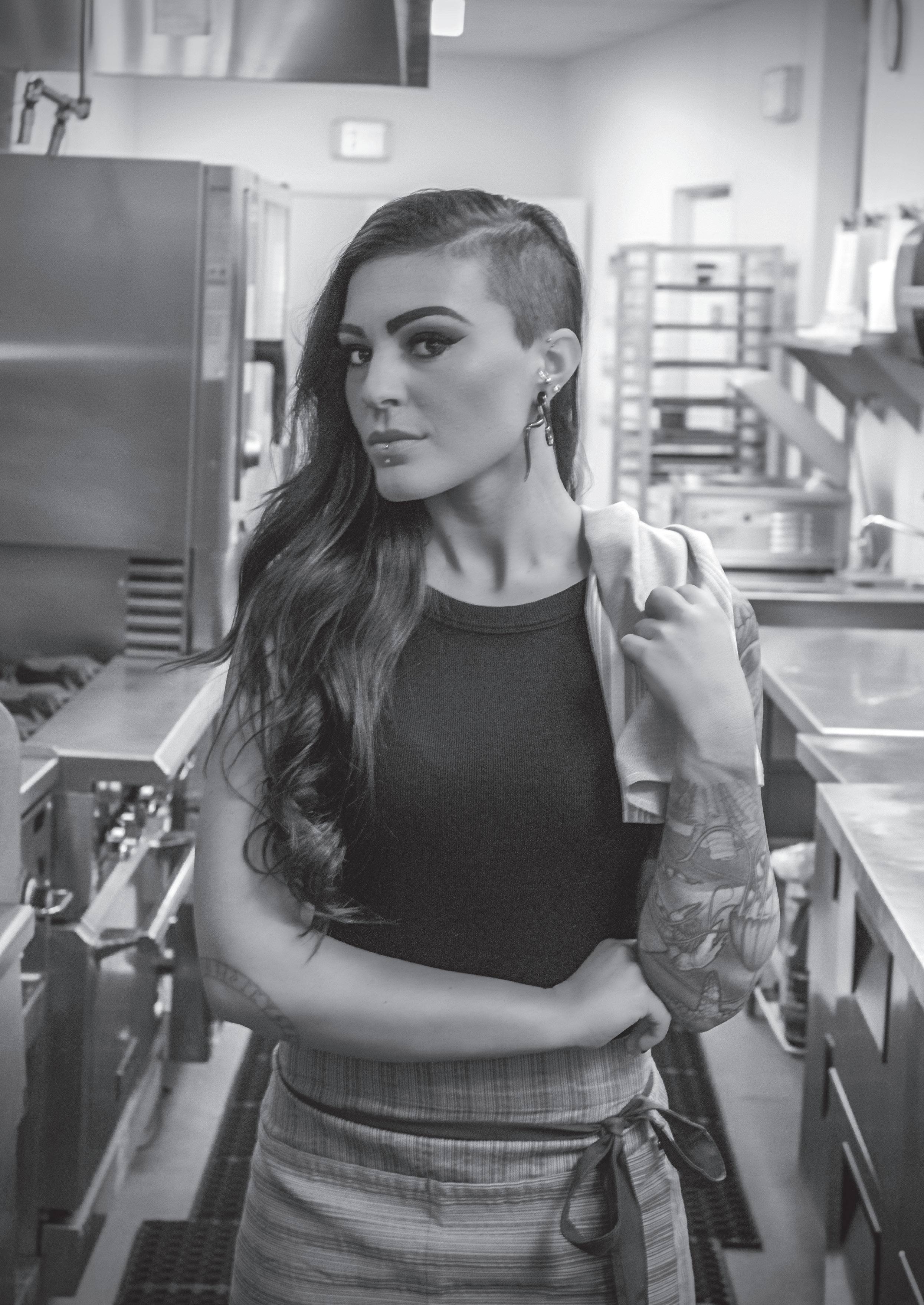
GK: Did you return MV the following season?
HFM: Yes, there’s something about the Vineyard that keeps a hold on your soul. From the smell of the fresh sea air, to the amazing product right outside your door, I had to go back and learn as much as I could. For the next three years, I returned and worked at a restaurant called Down Island under a very talented Chef, Scott Cummings. Down Island featured a five-course tasting menu that changed every week making it exciting for the locals and tourists, as well as ourselves.
GK: Tell us about your experience with Chef Cummings?
HFM: Chef Cummings made me the chef I am today; he molded me to be creative and welcomed my avant-garde culinary concepts. I’m forever grateful for Down Island because this was where I blossomed into the Chef I always aspired to be. I had found my niche.
Being seasonal for both The Everglades Club in the winters, and Down Island in the summers, I decided to stay year-round on Martha’s Vineyard. Let me tell you, it was a brave decision. The winters, oh my goodness! (laughs), I made it one full year. The winter wind was brutal; and being such a seasonal island, you lose track of the real world. I lived in a little cottage in the woods that was adorable and perfect but, it was cold! It was during that winter that myself and my two miniature greyhounds decided our blood was too thin for the chilly weather and I decided to come back to Florida where our hearts were.
GK: How did you land at Mizner Country Club?
HFM: When I returned to Florida, there was a vacant position. I was interviewed by the Executive Chef at the time, and it was the most casual interview I’ve ever had. I instantly clicked with the club, and I felt like this could be my new home. I wanted to show my worth, talent, and dedication, and I quickly climbed the ladder.
I was 26 at the time and took the role of sous chef. I wanted to change how the world views country clubs. I wanted to show that country club dining can be Michelin-style restaurant food in a country club setting. Within one year, I was promoted to Executive Sous Chef.

Golf Kitchen Magazine 18
The Craft Grill

Miizner Country Club 19
GK: How were your ideas received at the club?
HFM: The Mizner management gave me the freedom and support to make my job an everyday adventure! That is why I feel at home here. Out of the box pairings, creative works of art as a dish, and new concepts feed my hungry heart. To be an Executive Chef was always my goal; I watch, observe and execute. I am the most demanding of myself in terms of mastering something. It’s not unusual for me to be in the kitchens until 1:00 AM teaching myself new techniques. In my mind, I was training myself to be an Executive Chef and reach my goals. Failure was not an option. I knew that even if it weren’t at Mizner, I would need to learn as much as I could to excel in my future.
In October 2020, I assumed the role of the Interim Executive Chef. In November 2020, Mizner made it official. Hannah Flora-Mihajlovic as Executive Chef. My childhood dream and everything I have pushed myself to be was now manifesting into the universe. Time to make waves.

GK: How did it feel to have the role officially just six days before Thanksgiving and in the middle of a pandemic?
HFM: “Bring it on!” Covid-19 posed an unexpected, yet welcomed challenge. Luckily, my brain thinks in combination of extreme organization and hyperactive creativity, making it more than possible to execute over 400 Thanksgiving dinners flawlessly. We set up the library and boardroom as a satellite space to package over 400 Thanksgiving dinners. Under my direction, the team was able to execute this feat, allowing the membership to gain even more confidence in my new position.
Golf Kitchen Magazine 20
“ My childhood dream and everything I have pushed myself to be were manifesting into the universe— time to make waves ”
The Craft Bar

Mizner Country club 21
GK: What were some other innovations you created due to the pandemic?
HFM: We created the Mizner bubble within our community during the pandemic. Our team needed to make sure our membership knew that they were both safe and entertained as well as satisfied with our programming. It was then that we introduced “Craft-Mart”, a grocery store within our club walls that would provide home essentials as well as prepared meals available for online ordering and home delivery.
Our team created a Shopify platform for our members to order from their phones. Product was delivered to their doorstep and a notification of the confirmed delivery was sent. Watching the program unfold into a well-oiled machine was unbelievable. It truly was a well-orchestrated event behind the scenes.
GK: What changes did you make in regard to liquor and wine?
HFM: It took us a moment to accumulate our permits for alcohol sales, but we had a massive market for wine, and the membership showed great interest with sales from the online market. This ignited our decision in creating a structured and permanent Wine Boutique, where members could purchase wines in-house and have them delivered. They enjoy having the unique and curated wine selection from our Sommelier, Marc Etienne-Hoffmann
GK: What ideas would you like to implement at Mizner in the future?
HFM: I recently began experimenting with small plate tapas-style buffets where we have chef-attended stations that serve and create small plates right in front of the members; it’s always fresh, new, and different. Fresh and local is always our goal. Being in such a rich agricultural atmosphere, I want to bring only the best quality into the kitchens and onto the plates.
I will also be looking to implement an outdoor kitchen where we can offer brick fired pizzas and flatbreads as well as new and interesting items to showcase. Being in Florida, our weather is definitely something to take advantage of.
GK: How do you manage your team? Do you give them opportunities to be as creative as you have been permitted?
HFM: My way of management is hands on, creative and empowering. Keeping my team
excited , encouraged and supported, allowing my chefs own creative minds to blossom into something special. As a team, you set yourselves apart from the standards. There have been many restaurants and clubs that I’ve worked at personally where creative freedom isn’t always welcomed. My goal as the Executive Chef is to constantly swim against the currents and welcome new and fresh ideas under my leadership. Empowering, encouraging and allowing each individual thought process to come into play, makes Mizner kitchens a force to be reckoned with.
Having a strong art and dance background, I view my kitchens in a unique way. Working on the line during a service should be an elegant dance. Each individual has a role and a rhythm. When we all move in harmony, it’s a beautiful ballet. I encourage my team to be creative. After all, culinary is an ever-changing ocean, and I want to make the first waves. I never want to discourage my chefs creative thought process; I want to empower their creative side on a
personal level and witness how it comes into fruition on the plates. I often ask my staff, “What was your favorite childhood memory? How can you recreate that memory on the plate?” Then as a team, we create a beautiful menu full of memory and feelings that become our specials. If my team is excited to come to work every day because they’re doing something that they love, it’s going to show 110% passion and quality in our menus and improve the experience for the membership. My responsibility as their leader is to encourage that leap into their personal growth.
GK: How do you create your menus?
HFM: Creating menus is an intricate process. We invite the staff in before menu changes, to prep and plan together as a team with the leadership of our Restaurant Chef. I love to create new recipes for the kitchens with a combination of our individuality.
Golf Kitchen Magazine
“Each individual has a role and rhythm
22
When we all move in harmony, it’s a beautiful ballet.”
GK: Tell us what goes through your mind when creating a recipe.
HFM: What goes through my mind while creating a recipe is more of a story than an instruction manual. How can I re-create the feeling of calm, anger, passion, or home through food? Sometimes something as simple as a single smell can send my mind spinning into an eight-component dish. When I think of a recipe and how I’m plating it, I see shapes and colors. I use my sense of smell to bring me back to a moment in my life. How can I recreate that life experience on the plate for someone else? My feelings come through in my food, which makes it more personal to me.
I’ve always loved showing my emotion, commitment, talent, and passion on a blank canvas. Whether with paints, clay, dance, or food, a true experience will emerge leaving the individual experiencing it at awe. I absolutely love seeing the emotions of a creation I have molded together, be expressed on another individual. Often, my ingredient choices that I choose are opposites on the color wheel, but blended together in the perfect way can create an amazing work of art. That is my signature as a Chef.
GK: Tell us about your new Culinary Lab?
HFM: The Culinary Lab is a program I started with our HR department in June, to extend an opportunity for growth within our club. Growth is one of our values at Mizner and we pride ourselves to be able to extend any learning opportunity to our most important assets, our employees.
We offer one course per month over a 12-month period. This program is open to the culinary and service team. Our mission is to educate them with hands-on tours and masterclasses to better understand the depth of the culinary industry. It is a voluntary option to participate, yet if you attend all 12 classes, Mizner will completely fund an ACF certification for them. The incentive is to give our employees something that they can be proud of and build on top of their skills and career goals.
 RECIPE BY HANNAH FLORA-MIHAJLOVIC
RECIPE BY HANNAH FLORA-MIHAJLOVIC
Yield: 4 portions
Ingredients
• 4 Kumamoto Oysters
• 1/2 cup Watermelon Mignonette (see recipe)
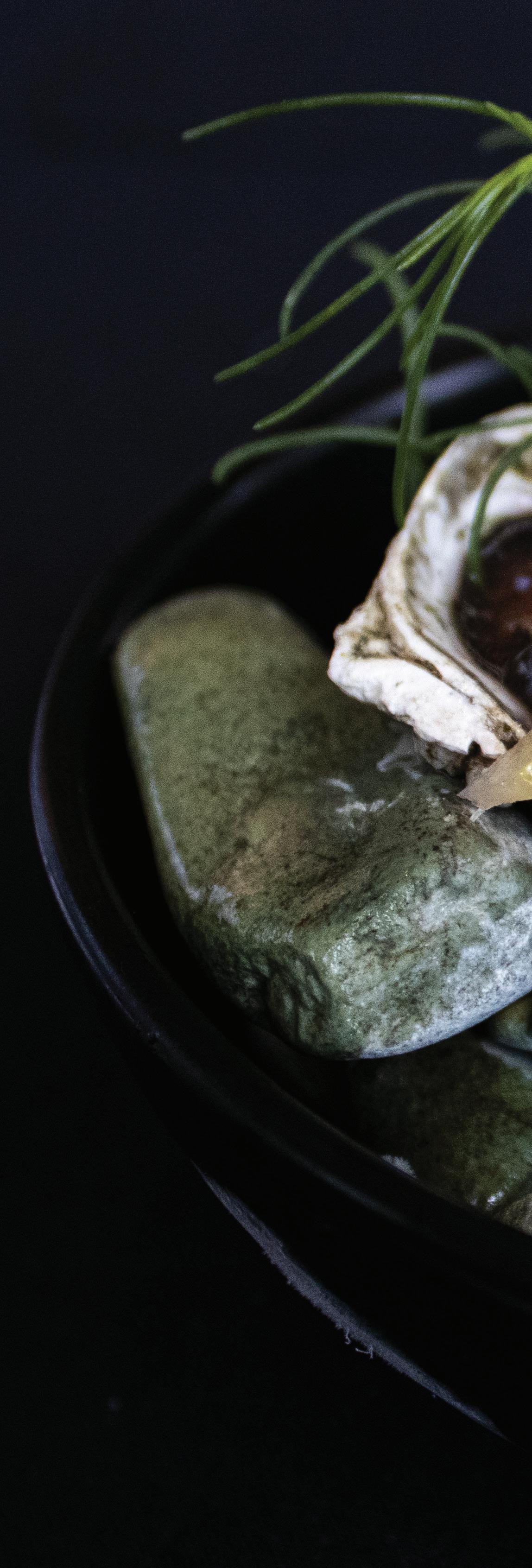
• 1/4 cup Pickled Watermelon Rind (see recipe)
• Preserved Lemon Rind
Watermelon Mignonette
• 2 Tablespoons Red Wine Vinegar
• 2 Tablespoons Watermelon Juice (fresh)
• 2 Tablespoons Seedless Watermelon (diced small)
• 2 teaspoons Scallion (minced)
• 2 teaspoons Mint (chopped)
• 1 Lime (zest)
Pickled Watermelon Rind
• 1/4 cup Watermelon Rind (brunoise)
• 1/4 cup Sugar
• 1/2 cup Champagne Vinegar
• 1 teaspoon Pickling Spice
Preserved Lemon Rind
• 2 Lemons (peel and chiffonade rind)
• 1/4 cup Champagne Vinegar
• 1/4 cup Sugar
• 1 cup Water
Garnish
• 1/4 cup Wild Blueberries (fresh)
• Calvin Pea Tendrils (supplied by The Chef’s Garden)
• Asian Signature Blend (supplied by The Chef’s Garden)
Extra Plating
• Beach Rocks
Preparation
Watermelon Mignonette
Mix all ingredients until incorporated, then chill.
Pickled Watermelon Rind
Combine all of the ingredients in a small saucepot. Dissolve the sugar and then cool.
Preserved Lemon
At room temperature, bring the lemon rind and water to a boil in a saucepot. Remove and drain. Continue this process three times. On the fourth time, add the sugar, vinegar, and blanched lemon. Bring to boil and turn off the heat. Let the lemon steep for 10 minutes then cool and reserve.
Kumamoto Oysters
Shuck the oysters and clean away from the shell then fill the cavity with watermelon mignonette and pickled watermelon rind.
Golf Kitchen Magazine 24
When I Fall into the Ocean I Am Home

Assembly
In a small bowl, place your beach rocks. Place the oysters on top of the beach rocks. Garnish with wild blueberries and preserved lemon, and micro greens.
Cocktail Pairing
Two Hundred
Ingredients
• 1 ounce Sipsmith Sloe Gin
• 3/4 ounce Lime Juice (freshly-pressed and double strained to remove the pulp)
• 1 Tablespoon Simple Syrup
• Champagne
Garnish
• Hibiscus Sugar Encrusted Champagne Glass

Preparation
Hibiscus Sugar
Blend the dried hibiscus flower with sugar in a blender until the mixture turns violet. Mist a champagne flute with water with a fine mist sprayer and dust in hibiscus sugar. Repeat the process until glass sugar turns shiny red and becomes encrusted on the glass to the stem. Leave the flute to dry on a clean bar towel for about 35 min. Mixologist Note: Do not use a paper napkin as it sticks to the sugar rim of the flute.
Two Hundred
Shake the sloe gin, lime, and simple syrup in a cocktail shaker. Strain into the hibiscus sugar encrusted champagne flute.
Serve immediately and top off with one ounce of champagne in front of the guest until two fingers under the rim. Mixologist Note: Make sure the champagne does not overflow as it dilutes the sugar and runs down the stem.
Inspiration
Champagne and oysters are a great pairing, as the subtle acidity of the champagne complements the salinity of the oysters. At the same time, the creaminess and bubbles round up the feeling in your palate. Champagne and herbaceous aromas of the gin are great partners too. I decided to use sloe gin, as it complemented the fruitiness of the watermelon and added a splash of lime to keep the added sweetness moderate.
~ Marc Etienne-Hoffmann Food and Beverage Operations Manager and Sommelier
Golf Kitchen Magazine 26

Marching to a Different Beet
 RECIPE BY HANNAH FLORA-MIHAJLOVIC
RECIPE BY HANNAH FLORA-MIHAJLOVIC
Yield: 4 portions
Ingredients
Carrot Ash
• 4 large Carrots
Beet Terrine
• 4 sheets Gold Gelatin
• 2 cups Water
• 2 Tablespoons Salt and Pepper
• Olive Oil
• 2 medium Golden Beets
• 2 medium Red Beets
• 4 petite Beets
• 1/4 cup Marcona Almonds (toasted and ground)
Pickled Mustard Seeds
• 1/2 cup Apple Cider Vinegar
• 1/2 cup Water
• 4 Tablespoons Sugar
• 1/3 cup Mustard seeds
Garnish
• Pickled Mustard Seeds (see recipe)
• 1 Dragon Fruit (scooped with a melon-baller for garnish)
• Goat Cheese (frozen)
• Egyptian Starflower Apple Blossom (The Chef’s Garden)
• Micro Beet of the Night (The Chef’s Garden)
• Citrus Lace (The Chef’s Garden)
• Cucamelons (The Chef’s Garden)
• Gold Chives (The Chef’s Garden)
• Beet Blush (The Chef’s Garden)
Preparation
Carrot Ash
Peel four large carrots into shreds and place them onto a sheet pan lined with parchment paper. Bake at 400 °F until burnt. Remove burnt carrot from the oven and pulse in a blender until it is a powder.
Beet Terrine
Bloom the gelatin in ice water for five minutes until soft. In a saucepan, bring the water and salt to a boil. Add gelatin and remove from heat. Dissolve. In a baking tray, cover the medium and petite beets in salt, pepper, and olive oil, cover with foil, and bake at 450 °F for two hours, until tender. Remove the petite beets after one hour and cool completely. On a mandolin, slice the medium beets thin and begin layering into a sprayed four by eightinch terrine mold. Pour gelatin over the terrine until covered. Cover with parchment paper and press. Place into the freezer and set for 10 minutes. Once set, remove from the mold and slice into one-inch slices.

Mizner Country Club 29

Pickled Mustard Seeds
In a saucepot, add all the ingredients and bring them to a boil. Once the sugar dissolves, reduce the heat to a simmer and cook for 30 minutes. Remove from heat and steep another 10 minutes. Transfer to a jar and keep refrigerated.
Assembly
On a medium plate, arrange beet terrine and petite beets rolled in carrot ash and Marcona almonds. Place small spoon fulls of pickled mustard seeds and dragon fruit around the plate. With a Microplane, shave frozen goat cheese over the dish. Garnish with microgreens.
Cocktail Pairing
Mezcal Margabeeta
Ingredients
Homemade Flower Ice Cubes
• Edible Violet Orchid
• Distilled Water
Mezcal Margabeeta
• 1 1/2 ounce Casamigos Blanco Tequila
• 1 1/2 ounce Nuestra Soledad Mezcal
• 1 1/2 ounce Beet (freshly juiced, raw)
• 3/4 ounce Lime (freshly juiced)
• 1/3 ounce Agave Syrup
Garnish
• Flower ice cubes (see recipe)
• Black Hawaiian Salt
Preparation
Homemade Flower Ice Cubes
In a round or square ice cube tray, add an edible violet orchid to each mold and top with distilled water.
Black Hawaiian Salt Rim
Take a wide pastry brush and brush the rim of the glass with lime juice. Mixologist Note: Hold the glass upside down to avoid juice from running down the glass. Over a spare plate, pour the salt over the glass rim while turning the glass. Mixologist Note: Make sure the plate is dry so you can reuse the excess salt.
Mezcal Margabeeta
In a cocktail shaker with ice shake until the shaker freezes from the outside, about 10 seconds. Strain the mixture into a salt-rimmed, 12-ounce chemistry cylinder over the flower ice cubes.
Inspiration
The smokiness of the Mezcal complements the earthy notes in the beets and pairs well with the goat cheese aroma. I chose to use half Mezcal and half tequila to create a subtle smokey flavor not to overpower the almonds or the dragon fruit.
~ Marc Etienne-Hoffmann, Food and Beverage Operations Manager and Sommelier
Mizner Country Club 31
Release The Kraken

RECIPE BY HANNAH FLORA-MIHAJLOVIC
Yield: 6-8 portions
Ingredients
Octopus
• 1 Spanish Octopus (whole, rinsed)
• 2 Spanish Onion (roughly chopped)
• 4 cloves Garlic
• 2 cups White Wine
• 4 cups Water
• 1 Lemon (halved)
• 2 Tablespoons Salt
• 2 Tablespoons Olive Oil
• 1 Bay Leaf
• 2 sprigs Basil
• 2 whole Scallions
• 1 pinch Saffron
• Black garlic Puree (see recipe)
Miso Glaze
• 1/2 teaspoon garlic (minced)
• 1 Tablespoon Dark Brown Sugar
• 1/2 cup Sesame Oil
• 1/2 cup White Miso Paste
• 1/3 cup Soy Sauce
Black Sesame Sponge
For the Praline Paste (sponge base):
• 115 grams Black Sesame Seeds
• 25 grams Sesame Oil
For the Sponge Cake:
• 120 grams Sesame Praline Paste (see recipe above)
• 4 Egg Whites
• 3 Egg Yolks
• 80 grams Sugar
• 20 grams Wheat Flour
• Oil
Lemongrass Foam
• 2 cups Coconut Milk
• 2 stalks Lemongrass
• 3 Kefir Lime Leaves
• 15 grams Sugar
Black Garlic Pure
• Clean four bulbs of black garlic and blend in a Vitamix until smooth. Chef Note: Add a touch of water if it is too thick.
Garnish
• Blood orange segments
• Abbey Road Dianthus (The Chef’s Garden)
• Asian Signature Blend (The Chef’s Garden)
• Dill Blooms (The Chef’s Garden)
• Nasturtium Flowers (The Chef’s Garden)
Preparation
Octopus
Sauté the garlic and onion with olive oil in a pan until translucent. Add wine and herbs. Add the rinsed octopus to the pot, and cover it with water. Cover with a lid and simmer for three hours or until tender. Remove the octopus from the liquid, discard the head, and cool. Cut the tentacles and marinate with miso glaze for one hour. Grill the octopus for four minutes until charred.
Black Garlic Puree
Clean four bulbs of black garlic and blend in a Vitamix until smooth. Chef Note: Add a touch of water if it is too thick.
Miso Glaze
In a pan, sauté the garlic with sesame oil until lightly caramelized. Turn off the heat and add the brown sugar. Stir together until dissolved into a paste. Add the white miso, soy sauce, and mix together. Remove pan from heat and reserve for glazing the octopus.
Black Sesame Sponge
For the Praline (sponge base): Add the black sesame seeds and sesame oil to a Paco jet and freeze overnight. Spin in the Paco jet, or empty into a Vitamix Blender and mix until smooth, then pass through a china cap.
For the Sponge Cake:
Mix all of the ingredients. Pour into an ISI. Charge 4x. Spray microwave-safe cups with oil. Dispense the mixture into cups, half full. Microwave for ten seconds on high, then immediately flip over the cups to release the sponge. Tear up into pieces for garnish and set aside.
Lemongrass Foam
In a saucepan, add all ingredients and simmer on low until the sugar has dissolved. Turn off the heat and steep aromatics for 10 minutes. Remove from pot and cool. Once completely cool, pour into the ISI Charge 2x. Reserve in cooler until plating.
Assembly
On a small plate, place the octopus off-center. Dot black garlic puree around the octopus. Garnish with blood orange segments, black sesame sponge, and microgreens. Dispense foam over the octopus.
~ see over for Cocktail pairing
Mizner Country Club 33

Cocktail Pairing
Tokyo Lima Sour
Ingredients
Garnish Homemade Campari Dust (see instructions)
Tokyo Lima Sour
• 1 3/4 ounce Honjozu Sake
• 1/3 ounce Peruvian Pisco
• 1 ounce Lime Juice (freshly squeezed)
• 2/3 ounces Simple Syrup
• 1/2 Egg White
• Peychaud Bitters
Preparation
Homemade Campari Dust
Make a Campari mirror by adding about 150ml of Campari on a lined baking sheet and stick it in the oven at 170°F for about 30 hrs with a slightly opened door. Once the Campari has hardened, remove it from the baking sheet and blend it into dust.
Tokyo Lima Sour
Add the sake, pisco, lime juice, simple syrup, egg white, and bitters in a cocktail shaker and dry shake.
Mixologist Note: No ice and only with a strainer spiral to beat the egg white foamy. Remove the spiral and add ice. Shake until the shaker frosts from the outside, and double strain in a coupette glass with a Campari dusted rim.
Inspiration
The lime cuts through the umami flavor from the miso, while the sake and pisco are light in taste and compliment the Asian notes without overpowering the lemongrass. The Peychaud bitter adds depth to the drink while the Campari dust catches the sweet and bitter notes of the blood orange.
~ Marc Etienne-Hoffmann, Food and Beverage Operations Manager and Sommelier

The Library
RECIPE BY HANNAH FLORA-MIHAJLOVIC
Yield: 4 portions
Ingredients
Duck
• 2 Maple Leaf Farms Duck Breast
• Salt and pepper (to taste)
Peach Gastrique
• 1 teaspoon Butter
• 1 Shallot (minced)
• 4 Peaches (freshly ripened and diced smallmakes two cups)
• 3 teaspoons Sugar
• 3 teaspoons Cognac
• 3 teaspoons Apple Cider Vinegar
Cherry Demi-Glace
• 1 cup Cherries (fresh, pitted and crushed)
• 1 quart Veal Stock
• 1 quart Red Wine
Garnish
• 1/2 cup Duck Fat Crumb
• Abbey Road Dianthus (The Chef’s Garden)
• Banana Cream Viola (The Chef’s Garden)
• Citrus Lace (The Chef’s Garden)
• Black Mint (The Chef’s Garden)
• Sweet Pea Currant Tomato (The Chef’s Garden)
Preparation
Duck Breast
Place duck breast in the freezer for 10 minutes. Score skin at a bias lightly. Season the duck breast with salt and pepper. Over medium heat, place the duck breast skin side down in a sauté pan and press with a steak weight. Render the skin until crispy, draining off any excess fat—Reserve fat for duck fat crumbs. Once the skin achieves a golden brown color, remove it from the pan and allow to cool. Place duck breast in a cryovac bag and seal airtight. Set sous vide to 57c. Sous vide the duck for two hours, then remove from the water bath and bag. Finish cooking the duck in a hot pan skin side down to re-crisp the skin. Finish in oven at 350 °F for three to five minutes.
Peach Gastrique
Melt the butter in a pan, add the shallots, and sweat until translucent. Add the peaches and cook for four minutes until tender. Add the sugar, cognac, and apple cider vinegar. Continue to cook for another 15 minutes. Remove from heat and transfer to a blender—puree and pass through fine china cap.
Cherry Demi-Glace
Combine red wine and veal stock in a saucepot and simmer. Reduce by half. Remove from the heat and add the cherries. Blend the sauce until smooth—season with salt and pepper.
Assembly
On a large dinner plate, brush the cherry demiglace diagonally. Cut the duck breast in half and place along the sauce. Place peach segments around the duck. Spoon and drizzle the peach gastrique onto the meat. Garnish with duck fat crumbs, fresh cherries and microgreens and edible flowers.

Wine Match
Alden Alli 2017 Sunchase Vineyard Pinot Noir
Alden Alli naturally brings food and wine together as it was brought to life by celebrity chef Emeril Lagasse and pinot pioneer Dan Kosta For me, the structured tannins cut beautifully through the duck fat, and the powerful berry fruit mirrors the cherries without being overwhelming. The fresh peaches pair beautifully with the cardamom aroma and a mid-palate minerality pronouncing the freshness.
~ Marc-Etienne Hoffmann, Food and Beverage Operations Manager and Sommelier
Golf Kitchen Magazine 36
Duck Duck Peach

As Above So Below
 RECIPE BY HANNAH FLORA-MIHAJLOVIC
RECIPE BY HANNAH FLORA-MIHAJLOVIC
Yield: 4 portions
Ingredients
Blueberry Demi-glace
• 1 cup Wild Blueberries
• 1 quart Veal Stock
• 1 quart Red Wine
Short Ribs
• 2# boneless Wagyu Beef Short Rib
• 2 Tablespoons Olive Oil

• 1 large Onion (roughly diced)
• 2 large Carrots(roughly diced)
• 3 stalks Celery (roughly diced)
• 4 cups Red Wine
Apricot Jam
• 1 Tablespoon Whole Butter
• 2 Apricots (ripe, fresh, pitted and small diced)
• 1 1/3 cups Water
• 1/3 cup Lemon Juice (freshly squeezed)
• Lemon Zest
• 1/2 cup Granulated Sugar
Garnish
• Uni
• Petite Cherry Bomb Radish (The Chef’s Garden)
• Emerald Crystal Lettuce (The Chef’s Garden)
Preparation
Blueberry Demi-glace
Combine wine and stock in saucepot and simmer. Reduce by half. Remove from heat and add the blueberries. Blend the sauce until smooth. Season with salt and pepper.
Short Ribs
Preheat oven to 350 °F. Clean and season the short ribs with salt and pepper. In a frying pan, heat the oil. Sear all sides of short rib until golden brown. Remove from the pan and transfer to plate to hold. Add the onion, carrot, and celery to the pan over medium heat for five minutes. Add the red wine to the vegetables and simmer for three minutes. Add the short ribs to the pan and reduce the liquid by half. Cover with foil and place pan into the preheated oven and cook for 2.5 hours until tender. Let short ribs cool in liquid at room temperature.
Apricot Jam
In a small saucepot, add the butter and melt on medium heat. Add the diced apricots, sugar, water, and lemon juice. Cook for about 30 minutes until consistency begins to thicken. Reduce the heat to a simmer and cook an additional 30 minutes, stirring occasionally. Taste and add fresh lemon zest.
Assembly
Brush the blueberry demi-glace along the plate. Place the short rib on top of the demi-glace. Place the Uni on and around the short rib and garnish with wild blueberries. Spread shaved black radish around the dish and finish with extra sauce over the short rib.
Wine Match

Booker Vineyard Oublie Paso Robles 2017
Oublie, French for “ to forget”, is a beautiful reminder of the great red blends of Chateauneuf-du-Pape and comes with a serious Paso Punch. Powerful, yet balanced this GSM opens up with a peppery nose of dark red fruit, bramble, herbs, floral notes and graphite. The sweet red and blue fruit paired with liquorice on the palate remind me of a grown up version of a red twizzler. All is carried by a rocky minerality, lively acidity and grainy tannins creating a long finish.
Golf Kitchen Magazine 40
~ Marc-Etienne Hoffmann, Food and Beverage Operations Manager and Sommelier
Hole #7 at Mizner Country Club
Photo by: Evan Schiller
 RECIPE BY HANNAH FLORA-MIHAJLOVIC
RECIPE BY HANNAH FLORA-MIHAJLOVIC
Yield: 4-6 portions
Ingredients
Strawberry Marshmallow
• 6 Egg Whites
• 450 grams Corn Syrup Light
• 135 grams Water
• 250 grams Sugar
• 1 stalk Lemongrass
• 3 ounces Strawberries (puree)
• 12 sheets Gold Gelatin
Chocolate Praline Soil
• 25 grams Sugar
• 125 grams Almond Flour
• 75 grams All-Purpose Flour
• 55 grams Cocoa Powder
• 2 1/2 grams Salt
• 62 grams Butter (melted)
• 25 grams Hazelnut Paste
• 1/4 cup Feuilletine
Pineapple Fluid Gel
• 1/2 cup Whiskey
• 1/3 cup Water
• 1/2 cup Sugar
• 1 vanilla bean
• 1 Pineapple (cut into rings)
• 2 teaspoons Xantham Gum
Vanilla Brown Sugar Ice Cream
• 14 ounces Milk
• 3 1/2 ounces Cream
• 4 Egg Yolks
• 4 1/2 ounces Sugar (combine 2 ounces brown sugar, and 2 1/2 ounces granulated sugar)
Garnish
• Egyptian Starflower Apple Blossom (The Chef’s Garden)
• Banana Cream Viola (The Chef’s Garden)
• Citrus Lace (The Chef’s Garden)
• Micro Pennyroyal Mint (The Chef’s Garden)
• Frozen Cherries
Preparation
Pineapple Fluid Gel
Combine the water, whiskey and sugrar in a saucepot and reduce by half until you reach a syrup consistency. Cryovac all items together in a vacuum seal bag. Sous vide 85c for 35 min-1 hour. Remove from the water bath, add to a blender and blend on low. Slowly sprinkle in xantham gum until thick. Remove from the blender, then transfer to the cryovac bag again and compress until the color turns translucent. Transfer to a squeeze bottle and reserve for plating.
Vanilla Brown Sugar Ice Cream
Boil the milk and cream. Whip the egg yolks and sugar together by hand. Pour the yolks and sugar into milk then return to heat until it coats the back of a spoon. Strain then cool. Transfer to a Paco Jet and freeze overnight. Spin and taste.
Strawberry Marshmallow
Steep lemongrass in water on low heat for 10 minutes. Strain. Bloom 12 sheets of gelatin in cold water for 3-5 minutes. Drain the water. Set aside. In a mixer with a whip attachment, whip the egg whites until stiff peaks form. In a saucepot, combine the water, sugar, corn syrup, and strawberry puree until 248 °F is reached. Pull from heat and add the gelatin. Whisk until dissolved. With a mixer on low, stream the sugar mixture into egg whites. Continue to whip until the combination is room temperature and shiny—transfer the marshmallow to a lined and sprayed pan. Let set for about four hours. With a powdered sugar-dusted knife, cut the marshmallow into cubes. Toss in powdered sugar and reserve for plating.
Chocolate Praline Soil
In a mixing bowl, combine all ingredients by hand. Bake at 300 °F until dry, usually one hour.
Assembly
On a medium coupe plate, spread the chocolate praline soil into one line in the center. Place three marshmallows spaced apart along the soil. Cut one banana into 1-inch pieces. Dust with brown sugar and torch. Place the bananas in the negative space between the marshmallows. Dot pineapple fluid gel around each marshmallow.
Cocktail Pairing
Deconstructed Pina Colada
Ingredients
• 3 ounces Bacardi Superior White Rum
• 9 pieces Pineapple
• 6 Lime Quarters
• 1 1/2 ounces Agave Syrup
• 3 Aztec Chocolate Bitters
• White Chocolate Coconut Espuma (see recipe)
White Chocolate Coconut Espuma
• 1/2 pint White Chocolate Chips
• 1-pint Coconut Crème
Garnish
• Banana Flowers (The Chef’s Garden)
When I Split You Split We Split


Preparation
White Chocolate Coconut Espuma
Add the white chocolate chips and the coconut crème to a small pot. Heat the pot in a water bath and stir until melted. Add the mix into siphon bottle and charge with two capsules. Shake well and keep at 130 °F in a water bath. Refrigerate after service. Mixologist Note: A pan and stovetop might be quicker, but it destroys the delicate aroma of the white chocolate and coconut milk. The espuma will just taste like heated milk.
Assembly
Muddle the pineapple in a shaker with the white rum, bitters, and agave. Squeeze in the lime quarters and shake. Double strain in brandy balloon. Top decadently with the white chocolate coconut espuma and garnish with the banana flowers.
Inspiration

A tropical, deconstructed dessert asked for a tropical, deconstructed cocktail. At the same time, I wanted to mirror and complement some of Hannah’s flavors. Pineapple to connect both. Aztec chocolate bitters with the banana and white chocolate coconut espuma with the creamy marshmallows.
~ Marc-Etienne Hoffmann, Food and Beverage Operations Manager and Sommelier
That’s a wrap!
Golf Experiences for Her with Gia Liwski
Gia Liwski showed extraordinary determination to bring her vision Golf Experiences for Her® to an industry that was struggling to introduce women to the lifestyle of golf. I applaud her and highly recommend her program to all levels of the private golf and country club industry. ~
Diana DeLucia
GK: Gia, tell us a little about your background.
I grew up in central New Jersey together with my older sister, younger brother, and parents. I attended Rutgers Preparatory School, where I was a decent student and a better athlete. I began as a competitive gymnast, I skied, and I played basketball. Even as a child, I was very goal-oriented and had a solid work ethic, which was instilled in me by my parents. It wasn’t until I was 15, however, that I picked up my first golf club.
My parents had a home in LaBelle, Florida, which we’d visit in the winters. During one of those trips to Florida, my father first sent my brother and me for golf lessons. I began taking lessons at Oxbow Golf Club with a lovely British gentleman, Gary Keating, who lived there at the time. He was impressed at the speed with which I picked up the game and immediately encouraged me to pursue the sport full-time as he felt I had the potential to play at a collegiate level. I, however, had other plans. I wanted to play basketball in college. I found golf difficult, and I didn’t enjoy it. Regardless, and even though I didn’t have a clue what I was doing, I started entering junior golf tournaments and just tried to mimic what the other girls were doing.
In the end it paid off. I received a golf scholarship to the University of South Alabama, which was a bit crazy because I still didn’t feel like I knew what I was doing out there. Following my sophomore year at South Alabama I realized I wasn’t enjoying school as much as I wanted to be, and made the decision to return to NJ. I can clearly remember telling my mom over the phone what I was feeling and her saying: “Pack up your car and come home. We’ll figure it out.”
That was the summer of ‘96. I played some amateur events that summer against a couple of girls from Rutgers that I knew from junior golf. That fall, I walked on the Rutger’s Team, earned a scholarship, and by my senior year, I was co-captain. Coming home to New Jersey was the best decision I could have made.
GK: Tell us about your Television Series.
After working in the industry for many years, and at several great clubs with absolutely wonderful professionals, I was hired at Trump National Golf Club in Bedminster in 2004. I helped open the club and assisted in building their instructional from scratch.
It was a fantastic experience, but after two seasons, my brother kept pinging me about commercials that were running for the Fine Living Television Network and the network’s search for a new host for their show called The Wandering Golfer. I did an open casting call, and I was selected! I was once again out of my comfort zone, but I was over the moon with excitement. The crew and I shot 13 episodes that took me all over the globe.
In addition to a bunch of beautiful courses here in the US, we also traveled to the South Pacific, Australia, and New Zealand.
More so than the golf, however, I think it was the travel that inspired me most. I realized there was much more to golf than just the game—it is a lifestyle full of culture, cuisine, and unique experiences. During my time as the host of The Wandering Golfer, I interviewed everyone from golf legends like Arnold Palmer to groundskeepers in Costa Rica. I learned from everyone and found inspiration all around me.
“ More so than the golf, however, I think it was the travel that inspired me most. I realized there was much more to golf than just the game—it is a lifestyle full of culture, cuisine, and unique experiences. ”
Golf Kitchen Magazine 46

GK: What were some of your most memorable moments?
I met an Australian artist; he was in his late eighties. He was a fascinating caricaturist. He drew famous golfers, and they would sign his drawings. He didn’t play golf, but he loved the industry. In meeting with him, I realized that it wasn’t the game that I loved about the industry, it was the teaching, helping others, and everything that surrounded the game that drew me in most. I learned to surf on Bondi Beach in Australia. A little intimating doing this on camera for the first time, but nonetheless, I got up and savored the moment.
GK: What did you do when the television show ended?
When the show ended, I returned to New Jersey, moved in with my fiancé, dabbled with a few more regional television shows, and began teaching again full-time.
A few years later, in 2010, while down in Florida, I first began to visualize Golf Experiences for Her®. I found that the industry was missing something that catered to women and provided them with more than just a lesson on the tee or time on the course. I wanted to offer them what I loved about golf—and everything that goes along with it.
At that same time, one of the world’s best teachers and future Hall of Famer, Mike Adams, also asked me to take
a teaching position alongside him at Hamilton Farm Golf Club in Gladstone, New Jersey. I love working with Mike and enjoyed Hamilton Farm, but between 2012 and 2015, I had twins and then a third, and I recognized that I could no longer work the long hours of an in-season golf professional.
I wanted to adjust my teaching schedule, and my husband agreed. I struggled with it at first, and I missed my time at the club and that accompanying sense of my professional career. And although I loved raising my children, the golf industry was not ideally set up for working mothers. As a result of that sense of something missing, it pushed me back towards the idea I’d come up with years earlier.
In 2016 I started Golf Experiences for Her®. I began by running exclusive women’s clinics at Hamilton Farm and adding lifestyle elements—wine tastings, yoga on the beautiful fairways, cooking courses, fashion styling, and others—and my female guests responded eagerly. At first, a female guest instructor concept with so many details and added lifestyle elements was completely foreign to many clubs that invited me to host an Experience. It took several years to hone the concept, but the demand was there, and the phone started to ring.

GK: How did you secure bookings?
Many of my initial bookings came through other golf professional friends who recognized I had something unique to offer their membership. Other instructors
48 Golf Kitchen Magazine
Right: Gia Liwski Left Golf Experiences For Her guests.

Golf Experiences For Her guests enjoy a cocktail class.



 Lower center: Gia Liwski with Golf Experiences For Her guests
Lower center: Gia Liwski with Golf Experiences For Her guests
who followed me on Instagram reached out and wanted to add value to their already fantastic instruction programs.
Initially, I felt many clubs didn’t recognize that their female membership was starving for something new. As more events take place, however, and word-of-mouth spreads, more clubs are becoming receptive to stepping outside their traditional comfort zones.
GK: How did you switch gears when COVID-19 emerged?
At first, we had the lockdown, which was very challenging for all. But even as clubs started to reopen, the concept of group experiences was still challenging to pull off. Like so many others, the pandemic had an impact on my business as well.
I used the time to hone my programs. I created new event itineraries, collaborated with a variety of new lifestyle professionals to incorporate into my programs, and networked with a host of new clubs to line up events post-pandemic.
GK: Tell us about a typical day at a “Golf Experience for Her®” event.
Our events strengthen relationships and build comfort, leaving women feeling energized, enriched, and confident in their golf games, excited to spend time at their golf club and ready to accept their next golf invitation. Through Golf Experiences for Her®, we offer clubs and guests the opportunity to customize their day by supplementing their golf itinerary with a variety of lifestyle modules.
A typical day might begin with a working mimosa breakfast on the driving range, while I get to know my guests, review with them their pre-event questionnaire responses, and run them through a short individualized biodynamic body-assessment before moving to the instructional portion of the morning. Lunch will typically be a delicately tailored seasonal meal, paired with exquisite wines, and followed by a lifestyle experience that rounds out my guests’ day with something special and unique. And all our Experience guests leave with a gift or two that I personally select based on our special day.
My goal is to take care of my guests, and of course, showcase the club and its staff. I love working with the food and beverage staff to create female friendly bites for breakfast and dazzle the ladies at lunch. Over the years, I’ve learned that by the time we reach the lifestyle portion of our day, the la-dies and I have created a nice bond. It makes the day extra special when I host the mixology, cooking or fashion portion. Another wonderful way to showcase the clubs staff is to work them into the life-style portion, we’ve done everything from creating soups, charcuterie and cheese boards to learning to temper chocolate
GK: How can clubs contact you to arrange a Golf Experiences for Her® event?
Interested parties can visit my website at www.golfexperiencesforher.com DM on Instagram @trywithgia or email us at info@golfexperiencesforher.com
Golf Experiences For Her
Raising the Bar
A comprehensive dynamic and new approach to wine reviews for the private club industry.
Presented by Fernando Silva Sommelier and Artist
Wine, this amazing creation, has been part of our culture and history since Millennia. Wine can generate countless moments of pleasure, fuel deep conversations, keep you up through the night, and ignite your mind with creativity!
Wine speaks; fine wine in moderation makes us more sociable and, in some way, more passionate about life.
As an artist and sommelier, I believe there is a strong connection between the fascinating world of fine wines and the arts. I see both as expressions from the soul; they create a bridge connecting the senses with our intellect.

How we score Wines
95-100 Quintessential wine: Refined, elegant, and unique, a true expression of varietal, terroir, and winemaking skills
90-94 Formidable wine: a wine full of potential ready to become a true icon.
85-89 Brilliant wine: Usually fresh, vibrant, and on its way to growth.
80-84 Great effort: Enjoyable at many levels, easy party-going wine.
75-79 Good effort: Wines that are still developing character.
50-74 Needs improvement: You can drink it, but it needs some work.
Stone The Crows, Three Twins Vineyard, Napa Valley, California 2017
Winemaker Thomas Rivers Brown, Proprietor Richard Talmadge.
Hailing from St. Helena, this powerful yet refined red, with ripe dark fruit and lush, velvety tannins, a hint of black pepper, and fresh mint, seduce your palate with vivid acidity. Let the intoxicating blackberry and cassis aromas give way to a long finish.
GK 95

Golf Kitchen Magazine 52
Tarot, Napa Valley Cabernet Sauvignon, 2015
Jean Charles Boisset, Stephanie Putnam, Winemaker
An intriguing and delicious wine! This mighty Napa Valley Cabernet Sauvignon is full of dark fruit, blackberry, black cherry and hints of blue flowers, smooth tannins, and refreshing acidity. Fresh mint and lavender blend in a long finish bringing forth elegant aromas.
GK 93
Oublie, Booker Vineyard, Paso Robles, California 2017
Winemaker Eric Jensen
This one is for the fans of the Rhone Valley Wines. Here is a fantastic tribute to the Noble Wines from Southern Rhone.

Oublie is loaded with red berries, red cherry, and hints of licorice. Its bright acidity hits your palate right from the start giving way to lively and lush tannins. The blend is composed of Grenache, Syrah, and Mourvèdre.
GK 90
Barda, Pinot Noir Patagonia, 2015


Barda features some friendly notes of spices and packs of fresh strawberries and raspberries, followed by delicate notes of dried tea leaves. The man behind this project is Piero Incisa Della Rocchetta from Rio Negro (The Black River), located in the heart of Patagonia, Argentina.
Heads up! Barda might easily pass for a classic Burgundy.
GK 90
SUPPLIES THE MOST DISCERNING CONNOISSEURS WITH THE FINEST CAVIAR. WWW.HAUTECAVIARCOMPANY.COM 855.755.3833
Castiglion del Bosco, Brunello di Montalcino, Tuscany, Italy 2015.
Proprietor Massimo Ferragamo.
This full-bodied Brunello is full of black cherry, red plum, hints of cedar, and tobacco towards the end with fine but very evident tannins, precise and focused, enjoyable and fun till the last drop.

GK 90
Val de Flores, Malbec, Valle de Uco, Mendoza, Argentina 2013

Winemaker Michell Rolland
This timeless, complex, and rich Malbec is full of dark fruit, purple and blue flower notes, blackberry, red and black plum, and has a bitter cocoa finish.
The seductive aromas of violets and black pepper notes make this wine round and balanced with silky tannins. There is something about Val de Flores that makes me think of Pomerol.
GK 96
Dal Forno Romano, Valpolicella Superiore, Illasi, Verona, Italy 2013

A superb wine! This one puts all your senses into motion. It has great complexity on the nose and palate. Exquisite with a long finish; as expected, the tannins are robust but gentle.
Take your time when you taste this wine and notice the ripe red cherry, bitter chocolate, baked spice, and vibrant acidity.
GK 93
Domaine Sirech, Les deux Terroirs
Winemaker Alexandre Sirech
A little gem from La Gironde, the blend is made up of Colombard, Gros Manseng and Ugni Blanc.
This wine will surprise your palate. It is extremely refreshing with a complex nose, exuding tropical fruit notes, beeswax, and ripe guava, a great find!
GK 90
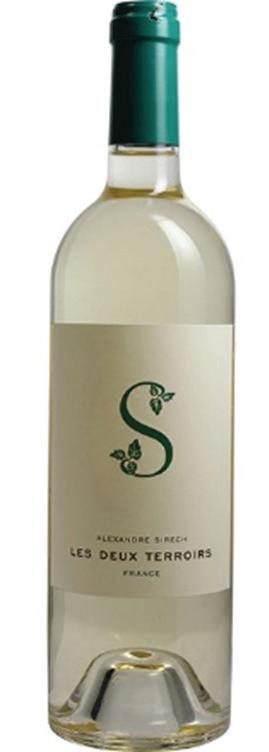
Golf Kitchen Magazine 54
Satyricon, Irpinia Campi Taurasini Rosso DOC, Campania, Italy 2018
Winemaker Luigi Tecce
This Aglianico is a Rockstar! Ready to drink and ready to party. There is a hint of light cooking spice with intense and vibrating red cherry and a solid backbone of acidity.
Traditionally Aglianico wines tend to require aging and time. Luigi Tecce’s Satyricon is made for instant pleasure.

GK 93
Chateau Fonplegade, Saint Emilion Grand Cru 2015

Denise Adams Winemaker
For the love of Merlot! This is such a fantastic wine with dark and red fruit, a combination of plum and crème de cassis; Fonplegade is simply a rich lushness of velvety fruit.
Full-bodied with a long finish, complex, rich from every angle. Great aging potential.
GK 95
Hyde de Villaine, HDV, Carneros, Napa Valley Chardonnay, California, USA 2017
Winemaker Stéphane Vivier, Proprietors
The Hyde and De Villaine Families.
HDV is a wonderfully made Chardonay that exudes citrus and white flower Aromas. It is enchanting from beginning to end, with a generous ripe green apple core, hints of peach and apricot, and decadent golden and silver hues.
GK 90
Puligny Montrachet, Domaine Joseph Drouhin, Burgundy, France 2018
Maison Joseph Drouhin, Laurent Drouhin.
A classic! This is a serious wine full of elegant citrusy notes. A charming hint of flintstone adds so much complexity to the glass—a light touch of tropical fruit and an ethereal character.
The acidity vibrates on your palate to finish delicately with notes of honeyed yellow apple. Elegant till the end.

GK 96

Raising the Bar 55

WINE AND SPIRIT EVENT SPECIALIST
discuss creative and flavorful ideas CONTACT WEI-LUI PORTFOLIO CONSULTANT E & J GALLO email: Wei.Lui@EJGallo.com cell: 347-452-1890 Instagram @WinebyWei
To
2021 AWARDEES
*Culinary Excellence Award for an Outstanding Private Golf Club or Country Club
Baltusrol Golf Club, Springfield, New Jersey
*Culinary Excellence Award for an Outstanding Golf Resort or Community
Reynolds Lake Oconee, Greensboro, Georgia
*Culinary Excellence Award for Outstanding Executive Chef at a Private Golf or Country Club
Edward Leonard, Fresh Meadow Country Club, Glen Cove, New York
*Culinary Excellence Award for Outstanding Executive Chef at a Golf Resort or Community
Bryan Skelding, The Greenbrier, White Suphur Springs, West Virginia
*Culinary Excellence Award for Outstanding Pastry Chef at a Private Golf or Country Club
Callie Meyer, Wycliffe Golf and Country Club, Wellington, Florida

*Golf Kitchen Rising Star Award
Hannah Flora-Mihajlovic, Mizner Country Club, Delray Beach, Florida
* Visionary Leader in Club Management Award for a Private Golf or Country Club
Martel Meyer, Richland Country Club, Nashville, Tennessee
* Golf Kitchen Purveyor of the year Award

Thomas Capobianco, HAFSCO
*Golf Kitchen Wine Program Award
GlenArbor Golf Club, Bedford Hills, New York
Presented by Laurent Drouhin
Wycliffe Golf & Country Club Wellington, Florida


Callie Meyer Executive Pastry Chef Wycliffe Golf & Country Club
In January of 2020, I had the honor of visiting Wycliffe Golf & Country Club to produce a magazine story and a book chapter. I was pleasantly surprised by the level of talent and excellence with all operations of the Club. Callie is no exception; her talent as an artist and communicator, paired with her love of the discipline of distance running, is a true testament to her character. ~Diana
DeLucia
GK: Tell us about your early experiences with baking.
CM: I was born and raised in Lancaster, Pennsylvania, which is about 70 miles west of Philadelphia. I lived in Pennsylvania until I was eighteen. It is a great farming community, and it was great having fresh produce available while growing up. The farmer’s market was right up the road, and we would frequent it nearly every Saturday in season. We also would visit Lancaster’s Central Market. All the local farmers and local bakers were there with produce and baked goods. Walking through the market, I fondly remember the smell of fresh-baked pastries and danishes. Experiencing that at a young age inspired me to explore the culinary arts when I got older. I have had a love for baking since I was five years old, and it is something that I have always treasured. I remember making Christmas cookies with my dad, who taught me much about the basics of baking.
After high school, I enrolled at the New England Culinary Institute in Burlington, Vermont. From there, I had two externships: one at Hotel Hershey and the other at the Greenbrier in West Virginia. Both externships were unforgettable experiences. Although the kitchen at the Greenbrier is enormous and intimidating, it served as a building block for my future. As a young chef, I was in awe of Executive Chef Peter Timmins. His apprenticeship program was one of the best. Sadly, Chef Timmons passed away in2014, but I will always remember everything he taught me.
GK: Did you study pastry initially?
CM: When I was doing my externships, I did a little bit of both. The New England Culinary Institute (NECI) wanted every chef to be well-rounded. They insisted we move around with our externships to learn as much as possible to prepare us for our future careers. When I moved to Florida in 2003, I worked as a sous chef at the Everglades Club in Palm Beach. I learned a lot under the chefs there, plus it was my first taste of the private club business. I stayed there for almost eight years, and then I came here to Wycliffe Golf & Country Club in 2011.
GK: What was your first role at Wycliffe?
CM: When I began at Wycliffe, I was in banquets for a while. I was helping the Pastry Chef when he needed it, and when he left the Club, they put me in the position temporarily while searching for someone more permanently. However, my “temporary” work with pastries changed their mind. In 2013, I was officially offered the position of Pastry Chef.
GK: I notice you are very popular with the membership. How did you win them over?
CM: First, I started talking to the members. I wanted to find out what they wanted in pastries and desserts. When visiting the ladies’ card room, I would bring them samples, offering them something new each time. I continued to do that, and over time, I was able to incorporate their feedback into new recipes – this really made the difference. After all, it’s about pleasing the members, and who better to ask what they prefer than them.
GK: It sounds like Wycliffe always is a big pastry/dessert club?
CM: They do appreciate fine pastries and
INTERVIEW Golf Kitchen Magazine 60
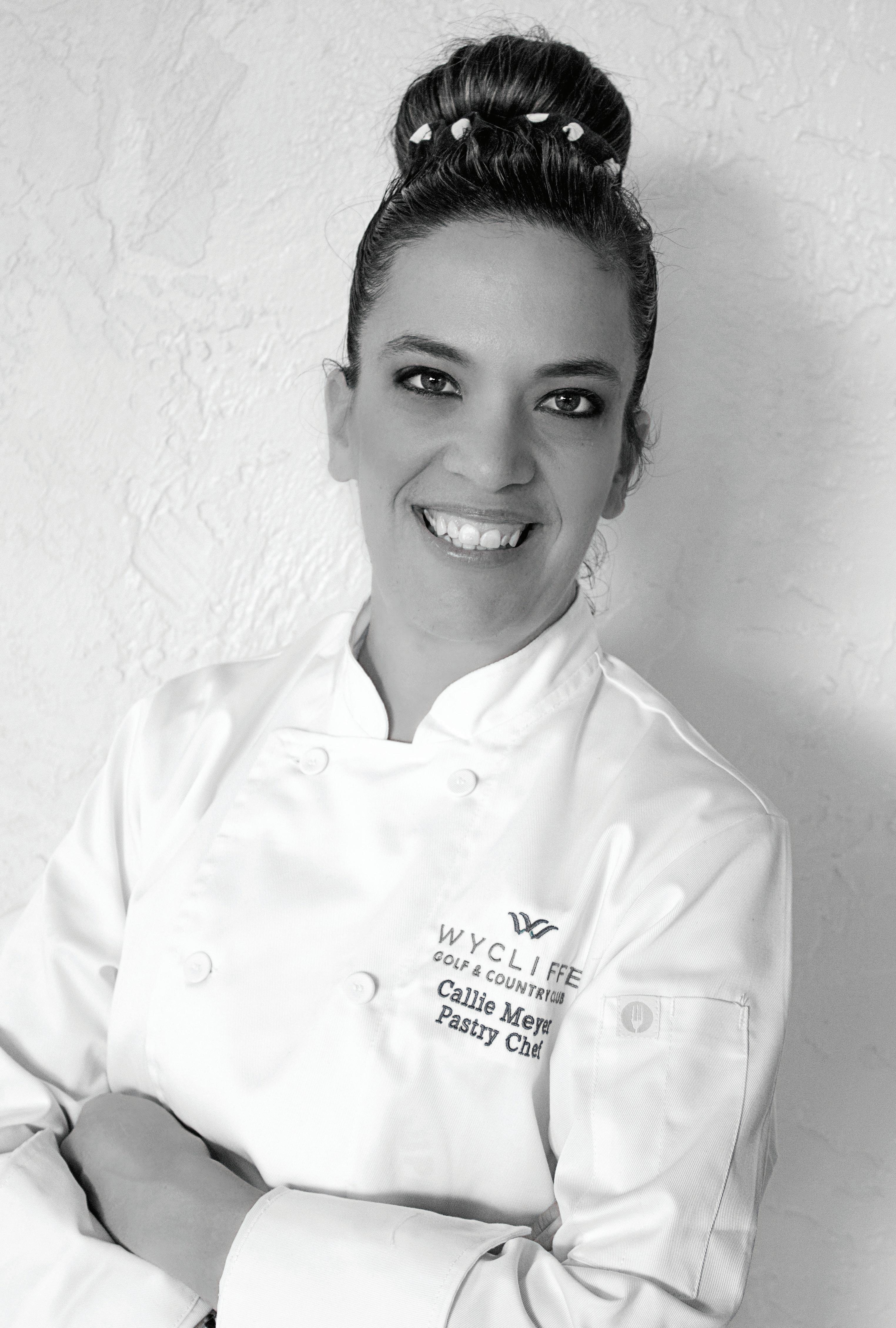
desserts. I love it when we have creative events that have a fun theme. Everyone can get involved.
GK: Tell us about some of those themes.
CM: We had a British theme, which was “jolly good” fun. We made a four-layer “Beatles/60’s British Invasion” themed cake. We supported the bottom with Styrofoam and actually spun it on a record player to a Beatles tune. Needless to say, it was a “hard day’s night” but we got it done!
Halloween is also always fun, and happens to be my favorite! Our members look forward to seeing all the spooky creations we come up with. We have many special events per season, and we try to exceed the member’s expectations every time.
GK: How do you and Executive Chef Christopher Park work together?
CM: Honestly, Chef Park is unlike any other Chef I have ever worked for or with – and I mean that in the best way possible! He is a true leader who encourages us every day. Chef is huge on inclusivity. While there may be times that he writes the main portion of the menu, more than anything, he looks to us for inspiration and creativity, especially when it comes to special events. Chef is a staunch supporter of the local farmer’s markets, and he always tries to use local produce wherever possible. Depending on availability, and because we are in Florida, most fruit and produce is available year-round. I’ll create a dessert surrounding the specific ingredient chef has in mind. Usually, this profile will reflect on what he has presented in the menu for the event.
GK: As a pastry chef, how do you source your product because you’re not necessarily married to the ingredients solely from the farms?
CM: I usually choose ingredients that are available from our sources that we know and trust to deliver quality ingredients on time and on budget.
GK: Do you dabble in molecular and scientific techniques?
CM: Our members prefer classic desserts. If I am experimenting with a molecular recipe, it’s a hit
or miss. My style is elegant, straightforward and clean, versus the scientific approach of molecular creations.
GK: What is the process when you are designing your creations?
CM: Let’s use the Key Lime Pie recipe we have published in this magazine as an example. How can I change the standard key lime pie into a more elegant dessert? I imagined adding a nice reflective glaze. Then I start thinking about what goes well with key lime. Maybe it’s cream or raspberries? Then I break it down even further. The components need to work well with a graham cracker base. Finally, I like to consider the tiny side elements, balancing the key lime’s creaminess and tartness. Once I have considered all these factors and the type and shape of the plate or vessel, I finalize the recipe and start creating.
GK: You create like an artist. That must come from somewhere.
CM: My entire family consists of artists. My dad is a creative director in advertising. My mom is a music, art and dance teacher, and my sister is a writer for Disney children’s television. We all have an artistic flair.
GK: What programs did you put in place during the pandemic and what will you retain from that period?
CM: The pandemic created challenges for everyone, maybe even more so for food service. During the early lockdowns, members were not coming in to dine. Take out was available, but we wanted to do more. Our members, who are usually very social, suddenly, like everyone else, had a lot of free time in their homes. Our pastry team came up with a creative way to fill some of that time with what we called “Take & Bake” program. We selected recipes that members could successfully bake at home, gathered all the ingredients into kits and made them available for pick up. Then, I posted a video on Wycliffe’s You Tube channel with detailed instructions on preparation and bake times. The members loved it – they would even send us photos that we’d include in our weekly publication. However, since our members are now back to enjoying being active and social, we have discontinued Take & Bake. It could be something fun to revisit on a special occasion.
Golf Kitchen Magazine 62
 Watermark
Image courtesy Wycliffe Golf and Country Club.
Watermark
Image courtesy Wycliffe Golf and Country Club.
 RECIPE BY CALLIE MEYER
RECIPE BY CALLIE MEYER
KEY LIME PANNA COTTA
Yields 12
Ingredients
Key Lime Curd
• 4 ounces Key Lime Juice
• 4 ounces Sugar
• 4 ounces Egg Yolks
• 1/2 sheet of Gelatin (bloomed)
• 1 ounce Butter
Vanilla Panna Cotta
• 16 ounces Milk
• 16 ounces Heavy Cream

• 6 ounces Sugar
• 7 sheets Gelatin (bloomed)
• 2 teaspoons Vanilla Paste
Mirror Glaze
• 4 1/2 ounces Water
• 8 ounces Water
• 8 ounces Glucose
• 8 ounces White Chocolate
• 10 sheets Gelatin (bloomed)
• 6 ounces Sweetened Condensed Milk
• Green Food Coloring
Key Lime Mousse
• 4 ounces Key Lime Juice
• 4 ounces Egg Yolks
• 4 ounces Sugar
• 8 ounces Cream (whipped)
Graham Cracker Crunch
• 2 cups Graham Crackers
• 4 ounces Butter
• 1/4 cup Sugar
Garnish
• Micro Mint
• Raspberries (fresh)
• Raspberry Coulis
• Crisp Meringue Rosettes
Wycliffe Golf & Country Club 65
Preparation
Key lime Curd
Whip sugar and egg yolks until thick. Heat Key Lime juice and temper into the egg mixture. Place mixture over a double boiler and cook until thickened. Add bloom gelatin and butter. Strain through a fine mesh strainer. Poor curd into small silicon domes and freeze.
Vanilla Bean Panna Cotta
Bring cream, milk and sugar to a simmer and add bloom gelatin strain. Add vanilla paste and pour halfway full into Silkomart Samurai mold. Chill. Add frozen Key Lime curd insert, pour remaining Panna Cotta over top and freeze.
Mirror Glaze
Boil water sugar and glucose. Add bloom to gelatin. Pour mixture over chocolate and add con- densed milk. Add a few drops of green food coloring to desired color. Chill.
Key Lime Mousse
Temper warm Key Lime juice into sugar and egg mixture. Place mixture over a double boiler and cook until thick. Chill. Fold in whipped cream.
Place in piping bag with small star tip and chill.
Graham Cracker Crunch
Mix together graham crackers, melted butter and sugar and place on sheet tray lined with parchment. Bake in a 325º oven until toasty, about 10 minutes.
Assembly
Unmold Panna Cotta. Over a wire rack, glaze the Panna Cotta with the warmed mirror glaze. Plate Panna Cotta with graham cracker crunch, Raspberry Coulis and crispy meringues. Garnish with micro mint and the fresh raspberries.
Wine Match
Moscato d’Asti- NV
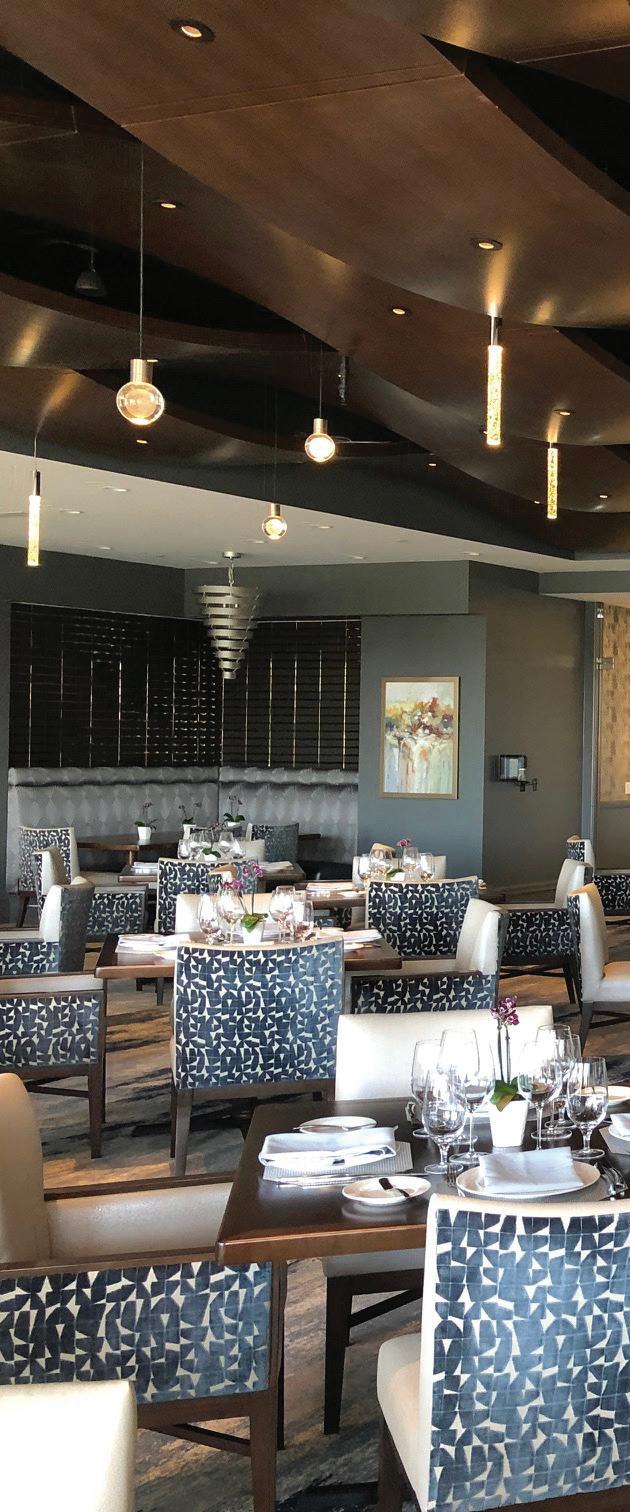
Golf Kitchen Magazine 66
Flavours Image courtesy Wycliffe Golf and Country Club.
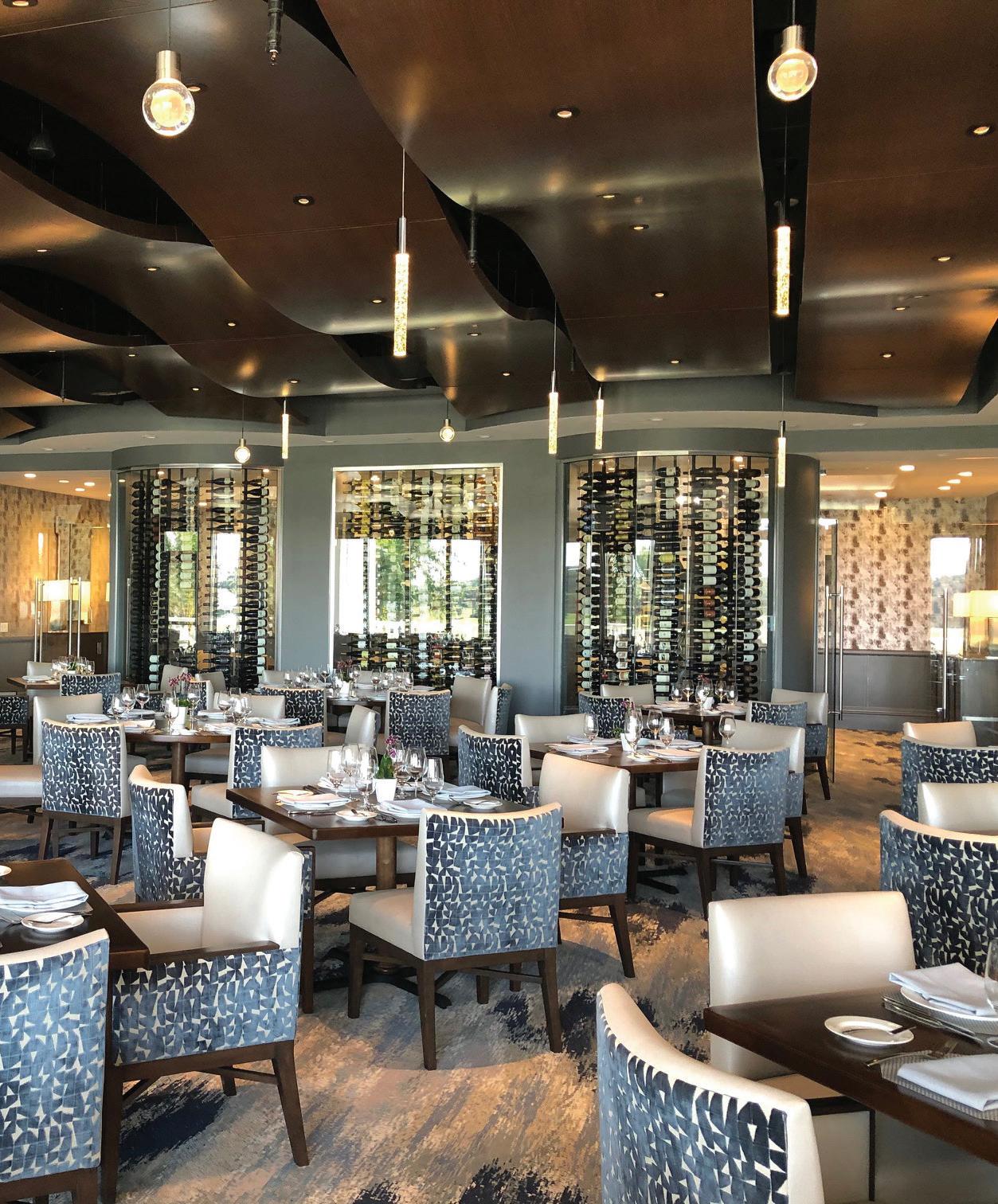 RECIPES BY CALLIE MEYER
RECIPES BY CALLIE MEYER
CHOCOLATE KAHLUA PETITE GATEAU
Yields 1
Ingredients
Chocolate Mousse
• 1 pound Cocoa Barry 58% or higher
• 1 quart Heavy Cream (whipped)
• 4 ounces of Egg Whites
• 2 1/2 ounces Egg Yolk
• 4 ounces Hot Coffee
• 2 1/2 ounces Sugar
Kahlúa Caramel Mousse
• 8 ounces Barry Zephyr Caramel 35%
• 4 ounces Heavy Cream
• 4 ounces Heavy Cream (whipped)
• 1 ounce Kahlúa
• 1 Tablespoon Coffee Extract
Chocolate Mirror Glaze
• 7 ounces Water
• 7 ounces Heavy Cream
• 1/3 cup Cocoa Powder (extra brute)

• 4 leaves Silver Gelatin (bloomed)
Hazelnut Dacquoise
• 5 1/2 ounces Hazelnut Flour
• 6 ounces Powdered Sugar
• 6 Egg Whites
• 2 ounces Sugar
• 1/4 teaspoon Cream of Tartar
• 6 ounces Melted Tempered Chocolate
• 5 ounces Feuilletine
Additional Items for Plating
• Fresh Raspberries
• Micro Mint
• Brownies (sliced thin and dehydrated)
Preparation
Chocolate Mousse
Melt chocolate over a double boiler and remove from stove. In a separate bowl whip the egg yolks until thick then add in the coffee and egg mixture and pour in the the melted chocolate. In a another bowl, whip the egg whites and sugar and fold into the chocolate mixture.

 The Cliffe
Image courtesy Wycliffe Golf and Country Club
The Cliffe
Image courtesy Wycliffe Golf and Country Club
The Terrace at Baltusrol Golf Club in the evening In a another bowl, whip the egg whites and sugar and fold into the chocolate mixture. Finally, fold in the whipped cream in three stages.

Kahlúa Caramel Mousse
Bring 4 ounces of cream to a simmer and pour over the Zephyr caramel chocolate. In a bowl whip the cream with 1 ounce of Kahlúa. Fold the Kahlúa whipped cream into the Zephyr caramel mixture. Place into piping bag with a small star tip.
Chocolate Mirror Glaze
Bring water, heavy cream and cocoa powder to a simmer. Let the chocolate mixture cool slightly, and add the bloomed gelatin. Chill.
Hazelnut Dacquoise
Sift flour and powdered sugar and set aside. Whip egg whites, sugar and cream of tartar to soft peaks. Gently fold the flour mixture into the egg whites. Spread evenly on a half sheet tray. Bake at 350°F about 10 minutes, or until it springs back. When cool, mix with the Feuilletine and tempered chocolate and spread a thin layer over the Dacquoise. Using Silkomart Fashion Eclair mold inside cutter, punch out 8 pieces.
Assembly
Fill Silkomart Fashion Eclair mold half way with chocolate mousse, followed by a thin layer of Kahlúa caramel mousse. Add the hazelnut Dacquoise insert. Fill the remaining portion of the mold with the chocolate mousse. Freeze. Unmold. Warm the mirror glaze and pour it over the frozen mousse on a wire rack and let the glaze set. Plate with the remaining Kahlúa Caramel mousse, fresh raspberries, brownie crisps and micro mint.
Wine Match
Dow’s 10 year Tawny Port
Wycliffe Golf & Country Club 71
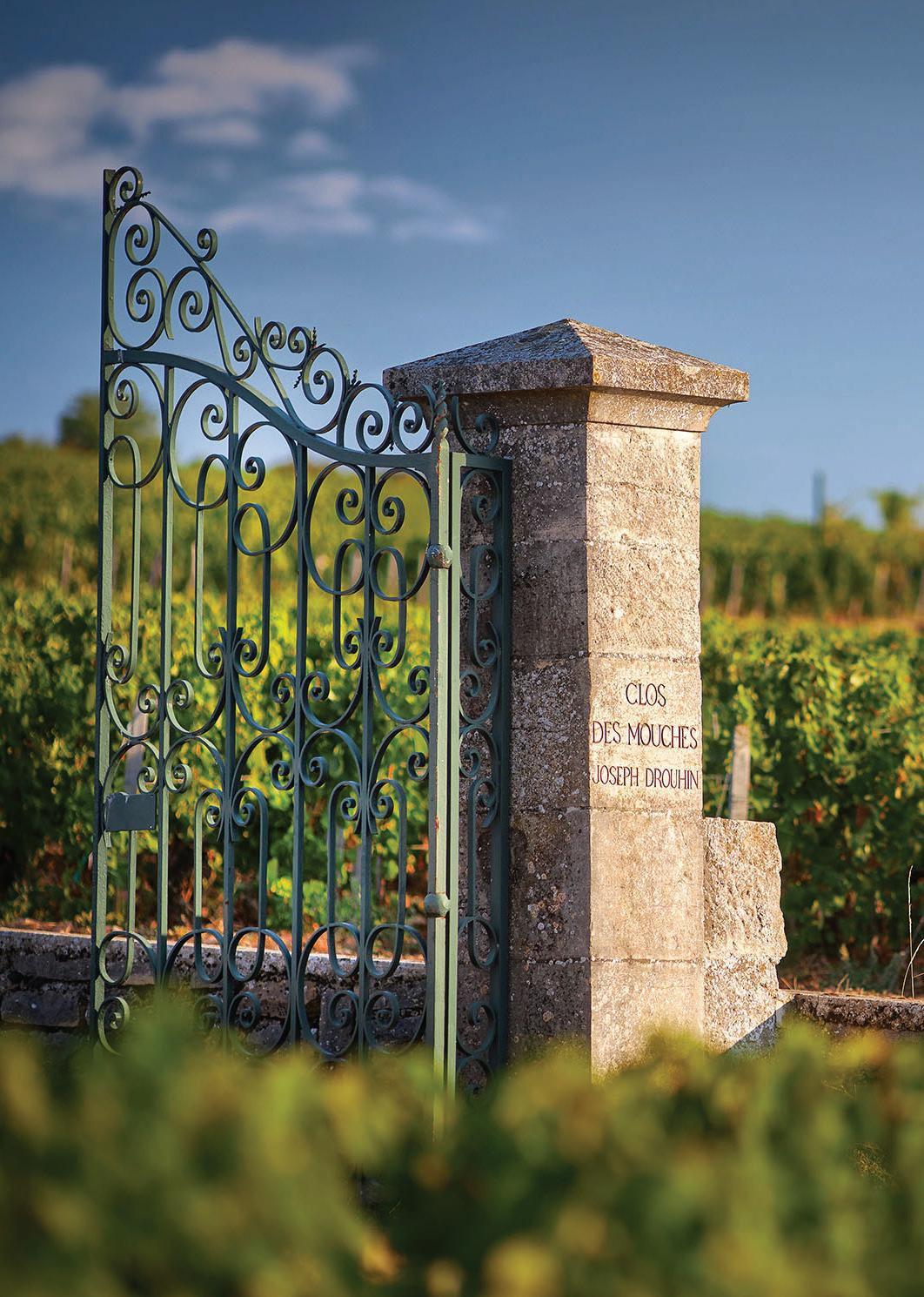 Joseph Drouhin, Clos des Mouches vineyard.
Joseph Drouhin, Clos des Mouches vineyard.
Joseph Drouhin
100th Anniversary Clos Des Mouches

Clos des Mouches
This intriguing name belongs to a great Burgundy wine from one of the most reputed Premier Cru vineyards in the Côte de Beaune region.
The mystical aura of Clos des Mouches is perhaps due to its fortuitous origin, its fabled history and, above all, its incomparable wealth of aromas and flavors that have earned it the loyal following of wine connoisseurs around the world.
For decades now, Maison Joseph Drouhin has devoted all its passion and knowledge to assuring the glorious heritage of this wine and the great moments of pleasure for those drinking it and sharing it.

A smiling landscape.
A few miles from the center of Beaune, at the turn of a country road, here are two tall stone pillars and an elegant wrought-iron gate. This is the entrance to the Clos des Mouches vineyard of Joseph Drouhin. A stony path, a few almond trees, cherry trees, peach trees…a little further is a small house used in the old days by pickers to take their meals. Today, this is where Joseph Drouhin organizes outdoors tastings and picnics for their honored guests.
The view from here is quite extensive: to the north, there is the hill of Corton; north-east, the famous multi-colored tile roofs of Beaune; south, Pommard with
its square church tower; and beyond, the villages of Volnay and Meursault. Rows of vines, leafy trees and a few houses: an impression of calm and timelessness pervades this landscape. Before falling in love with the wine, you fall in love with the place.
An ideal location.
The Clos des Mouches vineyard is located at the southern end of the Beaune appellation and borders Pommard. The Joseph Drouhin estate is entirely situated in the middle of the hillside (where most Premier Crus are found), on a gentle slope oriented east, south east. It benefits from maximum sunshine and prevailing breezes.
Out of all the various parcels known in Burgundy as “climats”, this is one of the most favorable for making an outstanding wine.
A complex soil.
The vineyard occupies three distinct terraces, each one separated by a retaining stone wall. From one parcel to the next, there are variations in the soil which will eventually find their way in the wine and give it all its multiple nuances.
The soil in the top section of the vineyard is rather stony, while below, at the heart of the Clos, the limestone and marl bedrock is more prevalent, with here and there some outcrops of the “dalle nacrée”
Golf Kitchen Magazine 74
Robert Drouhin
(mother-of-pearl layer). This makes for good drainage in the subsoil and allows the roots of the vine to grow deeper in search of water and nutrients. At the same time, traditional plowing eliminates all unnecessary surface roots, while encouraging the roots to go even deeper. In addition, the high density planting (11,500 vine-stocks per hectare - 4,600 per acre) creates a healthy competition among the vines, another reason why the roots are forced to dig further down.
1918, First intuitions.
This is the year when Maurice Drouhin succeeded his father Joseph Drouhin, who had founded the Beaune merchant company in 1880. To further improve the quality of his wines, he decided to establish his own vineyard estate.

At a time when horses were still used for plowing and harvesting, it was difficult to travel over long distances. Maurice Drouhin’s first endeavor was therefore to choose vineyards closest to Beaune.
With remarkable foresight, he first acquired a small but perfectly oriented parcel in the vineyard named “Beaune Clos des Mouches”, half-way between Corton-Charlemagne and Montrachet.
A symbolic name.
Why “Clos des Mouches” (“Enclosure of the Flies”)? In those days, vineyard owners often had bee hives which they placed in the sunniest areas. These famous “flies” were in fact bees. They were called «mouches à miel» (honey flies) in Burgundy.
There were so many hives in this enclosure that the name came very naturally, in the same way other vineyards were given names like «clos des pruniers» (plum-trees) or «clos des amandiers» (almond-trees). The only difference is that the bee itself is emblematic: it stands for hard work, selfless sharing, humility, discipline and of course honey, this nectar whose taste and texture have long been associated with wine. In Burgundy, everything has relevance.
Parcel by parcel.
Maurice Drouhin had a strong, determined personality. He liked the terroir of Clos des Mouches, was convinced of its potential, and did everything in his power to develop its scale. This determination was rewarded when he was able to buy 41 small parcels from eight various proprietors.
Joseph Drouhin, Clos des Mouches family, second, fourth and fifth generation.

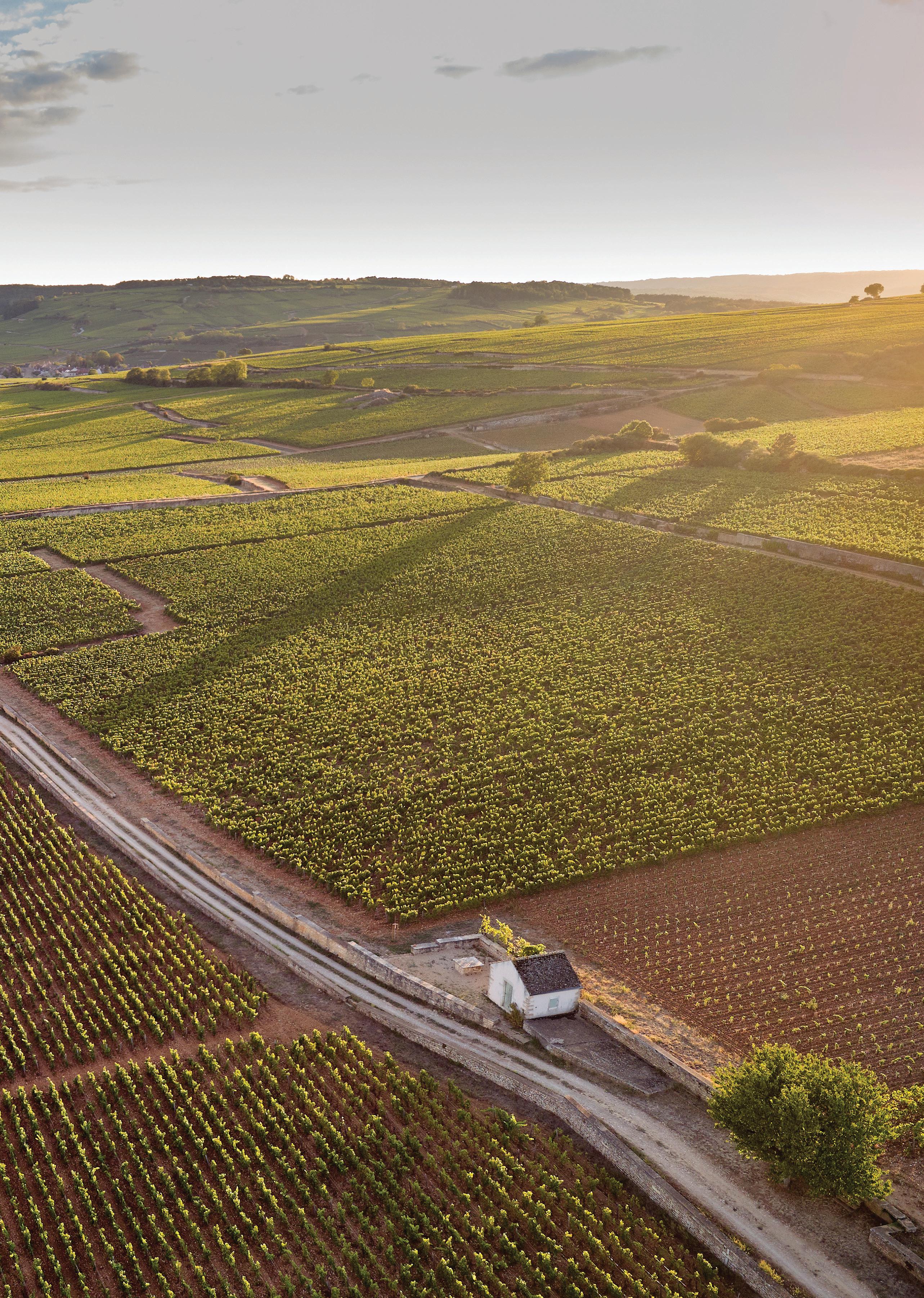 A skyview of Joseph Drouhin, Clos des Mouches vineyard.
A skyview of Joseph Drouhin, Clos des Mouches vineyard.
By 1929, he owned nearly 9 hectares (22.5 acres). Most of these new parcels had not been replanted since the phylloxera crisis in the 1880’s. Maurice Drouhin therefore had to pull out the diseased vines, replant with phylloxera resistant vinestocks, feed the soil and… wait. With the first vintage, he very proudly inscribed «Récolte du Domaine» (Harvest of the Estate) on the label.
1928: A prelude to fame.
In those days, the vineyards of Burgundy were mostly planted with the red pinot noir grape and a small percentage of white varietals such as pinot blanc, pinot gris (beurot), and chardonnay to add finesse and lightness to the wines. They were frequently mixed together in the vineyard. But Maurice Drouhin decided to do otherwise and planted the chardonnay separately for better care.

A lucky star over the vineyard.
In 1928, the chardonnay grapes ripened later than pinot noir. As a result, they were harvested and pressed separately. When he tasted this white wine born on a soil meant for red, Maurice Drouhin made the most wonderful discovery. To his surprise, the wine was refined, elegant and promised to age well. One of Maurice Drouhin’s good friends, Eugène Cornuché, shared the same opinion. He was the owner of Restaurant Maxim’s in Paris and he too was most impressed. Without hesitating, he placed an order for the wine and asked for the exclusivity in Paris.
«A la santé du tout Paris !»
This is how the Beaune Clos des Mouches blanc of Domaine Joseph Drouhin found its way to the wine-list of the restaurant that was all the rage during the roaring twenties. Among the «habitués» were H.M King Edward VII of Great Britain, entertainers like Mistinguett, Maurice Chevalier, Sacha Guitry, Yvonne Printemps, and other luminaries such as poet-dramatist Jean Cocteau and dancer La Belle Otero.
Someone apparently said about this decidedly exceptional wine: “its name makes you smile, but drinking it makes you swoon”…Clos des Mouches was launched and from that moment on, Joseph Drouhin offered both the red and white wines.
From grape to glass, the search for elegance and perfection.
Why the excellence of Beaune Clos des Mouches? Objectively, it comes from such elements as the quality of the soil and its exposition and the rigorous methods of vinification and aging. But on another and more important level, it belongs to something which cannot be measured, the passion felt by the Drouhin family for their domaine and the way this heritage - based on practical know-how and insight - has been passed along.
Maurice Drouhin for instance used to take his Sunday walk in the Clos in company with Robert, who succeeded him in 1957. A few years later, it was Robert
Golf Kitchen Magazine 78
Veronique and Philippe Drouhin
 A vine at Joseph Drouhin Clos des Mouches vineyard.
A vine at Joseph Drouhin Clos des Mouches vineyard.
himself who was taking his walk there, but with his four children, all of whom are now involved in the management of the House. What was discussed among them is not in writing.
The vine at its core.
Today, the Clos des Mouches comprises 14 hectares (35 acres) planted with pinot noir and chardonnay, at the southern end of the appellation. Joseph Drouhin has its own nursery and ensures the genetic heritage of its vines through “massal” selection, always on the look-out for the older “plants fins” (fine plants) whose berries have a thick skin and give a concentrated juice full of character. The vines range from 25 to 50 years in age. In the parcel called “le Prunier”, the vines going back to 1935 are still productive.

Starting in 1988, out of deep conviction, the House embraced biological methods in viticulture. Not to interfere with the organic life of the plant is the overarching philosophy. It permeates every facet of cultvation. Whenever necessary, compost is used to nourish the soil and plowing by horse in some parcels is still practiced.
Attention to detail.
Each parcel is harvested and vinified separately, at the right moment. It is not unusual to have up to seven
different “vendanges” (grape picking), for the white as well as for the red depending on the soil, the age of the vines, their elevation and their location in the vineyard.
Each “vendange” produces about ten “pièces” (barrels) which will be blended together (a pièce is the equivalent of 228 liters or 57 gallons). If necessary, the grapes are sorted twice: during picking, then on a sorting table in the cellars. Pressing is done very slowly so as to treat the fruit as gently as possible. The juices from the last pressing are not used. The cellar care varies slightly between white and red wines.
A precise aging.
Maison Joseph Drouhin is extremely particular regarding the quality of the barrels or the grain of the wood. The oak trees used for the barrels all come from French timber forests such as Tronçais. The weathering of the staves is entirely handled by Drouhin. This process is very important since it is the proper drying of the wood which, by keeping the finer tannins, will eventually contribute to the elegance of the wine.
The making of the barrels is entrusted to a cooper near Meursault with whom Drouhin works very closely. The proportion of new oak barrels varies between 20 and 40% depending on the structure of the vintage. Tannins should never mask the delicacy of the wine. Each
Golf Kitchen Magazine 80
Vineyard ploughing at Joseph Drouhin Clos des Mouches
barrel is closely followed during its whole lifetime, a bar code allowing total traceability. The whites are put into barrel directly after the grapes have been pressed and the must decanted (débourbage). The reds are left a few days in a vat under controlled temperature (about 15°C - 59°F) to slow down the activity of the indigenous yeasts. The alcoholic fermentation can then begin naturally.
Terroir respect.
Joseph Drouhin wants to be in total control of the extraction process: extraction gives out color and substance but should never interfere with the finesse and typical characteristics of the wine. Vinifying a great red wine can be like infusing tea: the important thing is to find the ideal balance between too much or too little. After fermentation, the wines are put in barrels. This is when their ageing properly begins. During this whole period, it is only through tasting, barrel after barrel, that certain decisions are taken if necessary. Of course, the data obtained in this fashion is always validated by the oenologists. Nevertheless, the “taste memory” is an essential asset: no wine will leave the cellars without the Drouhin family’s seal of approval.
As for all wines produced by the House, the absolute priority is given to the expression of terroir and the character of a particular vintage.
In search of excellence.
The facts speak for themselves:
During the summer of 2004, there were two violent hail storms that struck and “bruised” the berries of the Clos. The pinot noir grapes, whose skins macerate with the juice during vinification, suffered the most.
In 2006, Frédéric Drouhin, the President, together with the technical team, decided not to put the 2004 vintage of red Clos des Mouches on the market.

They believed that it was not up to the standards expected from such a wine. It was therefore “declassified” and sold under the appellation Côte de Beaune. This is the first time that such a decision was taken and it is ample evidence that the fourth generation is committed, more than ever, to the pursuit of quality: a cornerstone in the reputation of Joseph Drouhin.
Article and images: Courtesy Laurent Drouhin and Maison Joseph Drouhin.

REED Foundation for Autism honors AnthonyVillanueva Executive Chef Edgewood Country Club

On July 19, 2021, the REED Foundation for Autism held its first annual Golf Classic honoring Chef Anthony Villanueva of Edgewood County Club. Hosted by Atlanta Falcons Duron Harmon and wife Christine, Chef Tony was a natural fit to be honored for his ongoing support of the REED Foundation for Autism and Greens Do Good, a hydroponic, vertical farm located in Hackensack New Jersey.
REED Foundation for Autism is part of REED Autism Services full family of programs which includes a private school for students between 3 and 21 years of age, adult day and residential programs as well as a hydroponic farm that provides crucial workforce development and paid employment opportunities to individuals with autism. At REED Academy, the highly trained, dedicated staff focuses on each child’s needs, applying the highest standard of individualized and specialized education. We know that each year, approximately 50,000 individuals with autism spectrum disorder (ASD) turn 18 and edge toward aging out of their educational entitlements. That’s where REED Next comes in. Our latest endeavor is designed to support adults with autism ages 21 and older so that they can achieve greater independence and live a meaningful and fulfilling life. With REED Next Residential Services, adults with autism get the support they need to live and thrive within the community.
One of the largest issues facing adults with autism is the lack of employment opportunities. Nearly half of all 25-year-olds with autism have never held a paying job. Greens Do Good not only grows delicious, nutrient rich produce in a sustainable and environmentally friendly way, but also provides job training and meaningful paid employment opportunities. Greens Do Good uses 90% less water and is more energy efficient than traditional soil farms.
Chef Tony is Greens Do Good’s first client, and greatest supporter. Thanks to Tony and clients just like him, we can increase our impact, expand our workforce development program, and hire more adults with autism. Each week, he receives crisp butterhead lettuce, fragrant and delicious basil, gorgeous microgreens and nutrient rich baby kale and arugula, delivered by adults with autism like Finnigan Ban. Finn is a REED Academy graduate, Greens Do Good employee and attended the Golf Classic to help with registration and later entertain guests playing his guitar and singing fan favorite songs.
We are proud to dedicate our first golf outing to Chef Tony. Thanks to him and funds raised during the outing, cocktails, dinner and silent auction, we can continue to provide critical vocational training in sustainable agriculture and paid employment opportunities to teens and young adults with autism.

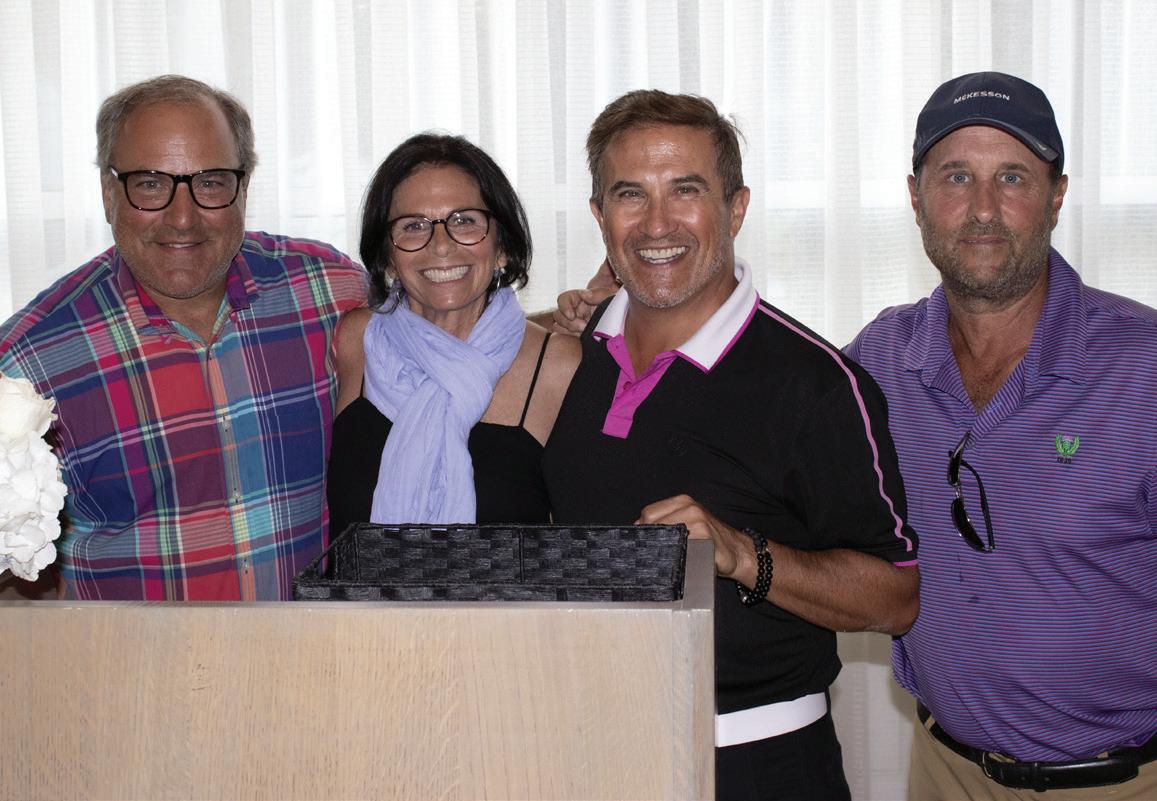


 Anthony Villanueva with Lawrence and Elizabeth Goldman
Roger Gross, Lisa Goldstein VP of Development, REED Foundation for Autism, Larry Gold, Dan Dennenberg.
Anthony Villanueva with REED Autism Services Board Member, Ken Nicholas.
Peter Ban with Finnigan Ban, a Greens Do Good employee.
Duron Harmon Atlanta Falcons, Nakia Griffin New York Giants,Anthony Villanueva, Devin McCourty New England Patriots.
Anthony Villanueva with Lawrence and Elizabeth Goldman
Roger Gross, Lisa Goldstein VP of Development, REED Foundation for Autism, Larry Gold, Dan Dennenberg.
Anthony Villanueva with REED Autism Services Board Member, Ken Nicholas.
Peter Ban with Finnigan Ban, a Greens Do Good employee.
Duron Harmon Atlanta Falcons, Nakia Griffin New York Giants,Anthony Villanueva, Devin McCourty New England Patriots.
The heartfelt speech that brought everyone to tears.
Thank you so much for ALL OF YOUR SUPPORT for this great and wonderful cause.
Lisa is a good close friend of mine for many years now. She is a very powerful lady that is passionate and giving. Also a very good speaker and persuasive person! She is a gem and is always there with a genuine smile and a great advocate for her causes!

I have been blessed with a beautiful family and wonderful career! But that is only what I do and not who I am! Who I am is more about this cause and giving back as much as I can. We are all from different walks of life but are all here today for this common good. That is greens do good. God gives us all special and unique talents in life. It is our choice to use that gift that makes a difference in other peoples lives. No better feeling or reward than to give and help others that are in need.
The rewards for doing good far outweigh the joys of receiving! I could never enjoy the fruits of my labor without giving back something in return. This is what makes the world a better place. Countless selfless acts by people like you and me!
So many people and so many lives that are in sync for the common good. Lets all share and spread the message of greens do good! I tell everyone that at Edgewood our greens do good. What do your greens do!
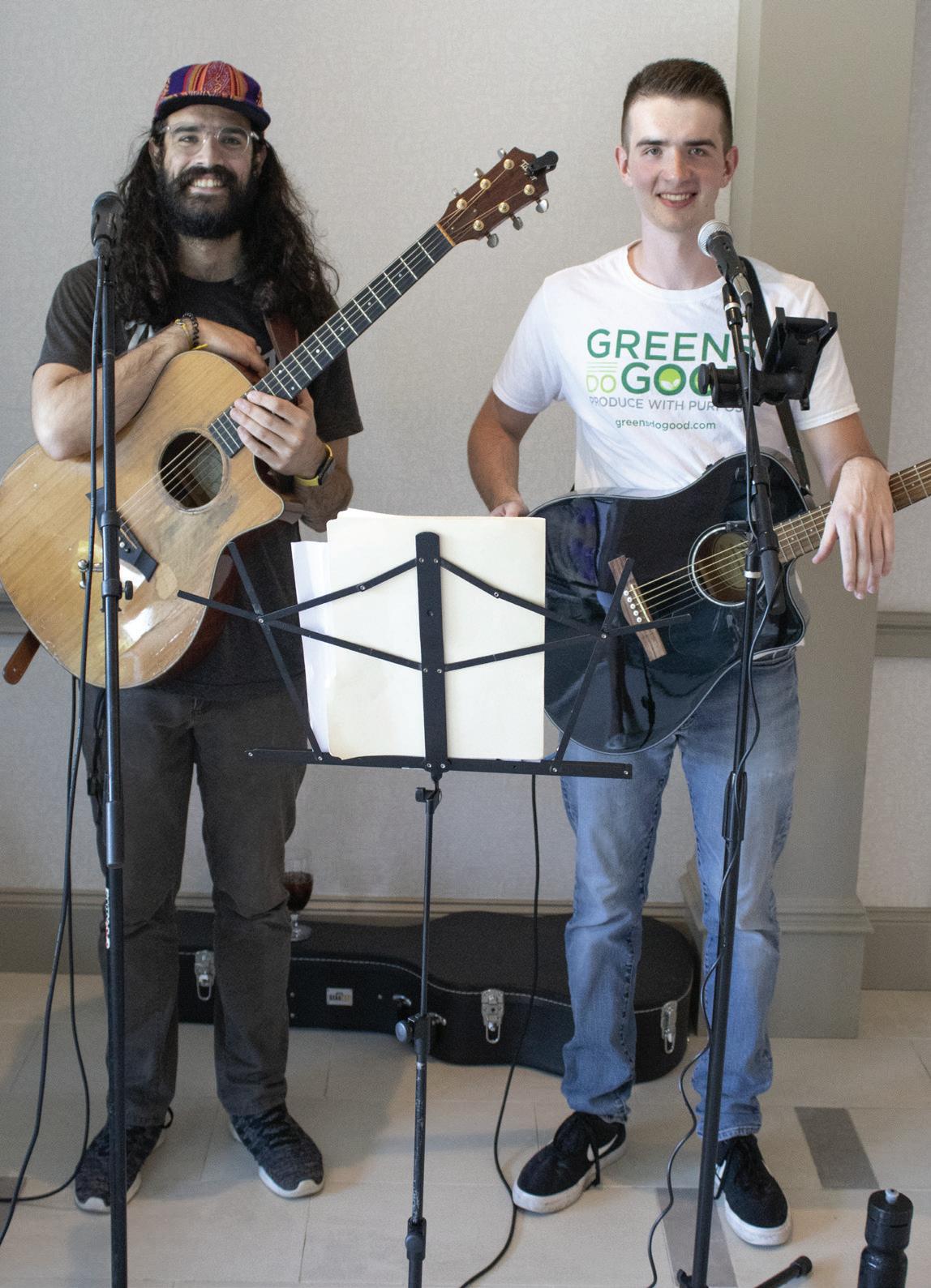
The stone that is cast into a lake can create a ripple effect that turns into a title wave! In life its never how the world treats us but how we treat the world to make it a better place!
I want to thank my family and wife who have supported my efforts through the years and have helped me on many occasions to conduct a charity dinners or run errands for me.

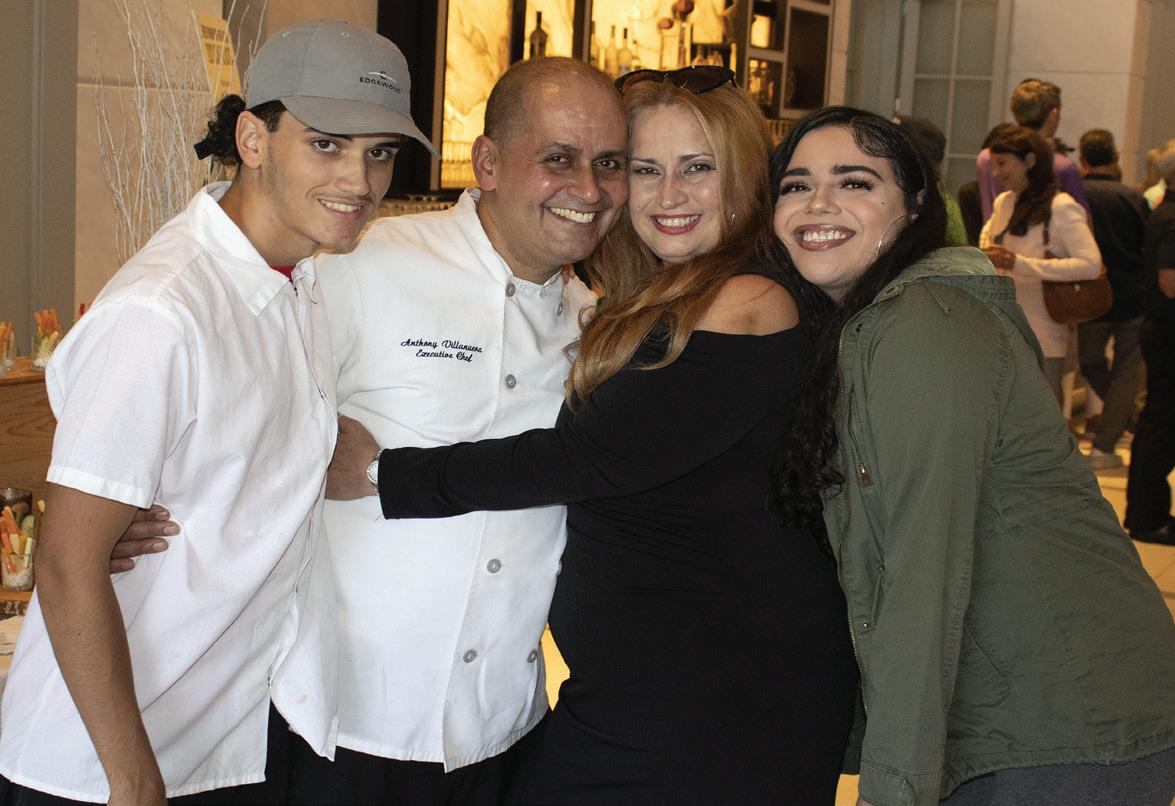
Let us celebrate the beautiful things in life and the precious moments and gifts we are all given. The real message of greens do good!
Thank you all!
~ Anthony Villanueva
Anthony and Evelyn Villanueva with son Brandon and Daughter Regina
Anthony Villanueva with Beth Picciano of Ramsey Auto Group, Drew VanDuren, Andrew Waddell and Frank Minervini
Chantelle Walker REED Autism Services CEO, Scott Marshall REED Autism Services Board Chair. Nick Sagnella and Finn Ban.

COMING SOON

Clubhouse Cocktails
PRESENTED BY GOLF KITCHEN
HOST
Shaun C. Lewis
EXECUTIVE CHEF AND ASSISTANT GENERAL MANAGER LIBERTY NATIONAL GOLF CLUB





































 The 8th Green at Mizner Country Club
Image by Evan Schiller
The 8th Green at Mizner Country Club
Image by Evan Schiller





 RECIPE BY HANNAH FLORA-MIHAJLOVIC
RECIPE BY HANNAH FLORA-MIHAJLOVIC




 RECIPE BY HANNAH FLORA-MIHAJLOVIC
RECIPE BY HANNAH FLORA-MIHAJLOVIC







 RECIPE BY HANNAH FLORA-MIHAJLOVIC
RECIPE BY HANNAH FLORA-MIHAJLOVIC


 RECIPE BY HANNAH FLORA-MIHAJLOVIC
RECIPE BY HANNAH FLORA-MIHAJLOVIC









 Lower center: Gia Liwski with Golf Experiences For Her guests
Lower center: Gia Liwski with Golf Experiences For Her guests



















 Watermark
Image courtesy Wycliffe Golf and Country Club.
Watermark
Image courtesy Wycliffe Golf and Country Club.
 RECIPE BY CALLIE MEYER
RECIPE BY CALLIE MEYER


 RECIPES BY CALLIE MEYER
RECIPES BY CALLIE MEYER


 The Cliffe
Image courtesy Wycliffe Golf and Country Club
The Cliffe
Image courtesy Wycliffe Golf and Country Club

 Joseph Drouhin, Clos des Mouches vineyard.
Joseph Drouhin, Clos des Mouches vineyard.




 A skyview of Joseph Drouhin, Clos des Mouches vineyard.
A skyview of Joseph Drouhin, Clos des Mouches vineyard.

 A vine at Joseph Drouhin Clos des Mouches vineyard.
A vine at Joseph Drouhin Clos des Mouches vineyard.








 Anthony Villanueva with Lawrence and Elizabeth Goldman
Roger Gross, Lisa Goldstein VP of Development, REED Foundation for Autism, Larry Gold, Dan Dennenberg.
Anthony Villanueva with REED Autism Services Board Member, Ken Nicholas.
Peter Ban with Finnigan Ban, a Greens Do Good employee.
Duron Harmon Atlanta Falcons, Nakia Griffin New York Giants,Anthony Villanueva, Devin McCourty New England Patriots.
Anthony Villanueva with Lawrence and Elizabeth Goldman
Roger Gross, Lisa Goldstein VP of Development, REED Foundation for Autism, Larry Gold, Dan Dennenberg.
Anthony Villanueva with REED Autism Services Board Member, Ken Nicholas.
Peter Ban with Finnigan Ban, a Greens Do Good employee.
Duron Harmon Atlanta Falcons, Nakia Griffin New York Giants,Anthony Villanueva, Devin McCourty New England Patriots.






